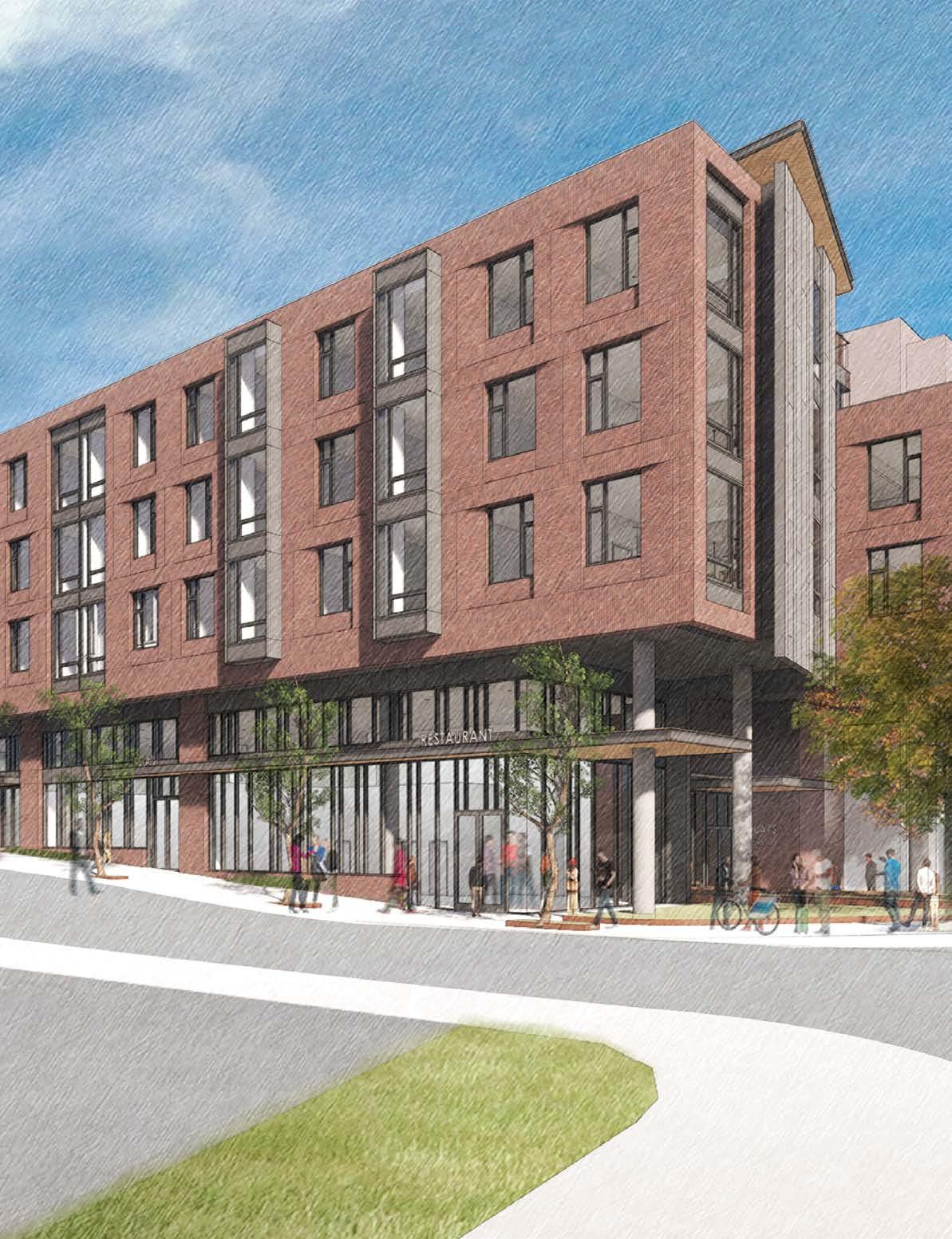
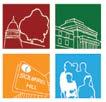
Vol 21 | Issue 2 Summer/Fall 2023 Magazine® MICRONEIGHBORHOODS HOUSING HELP VIOLINS OF HOPE MAKING A HOME
Our Mission
The Squirrel Hill Urban Coalition gives voice to the hopes and concerns of our residents, institutions, businesses and visitors and works to preserve, improve, and celebrate the quality of life in our vibrant urban Squirrel Hill neighborhood.
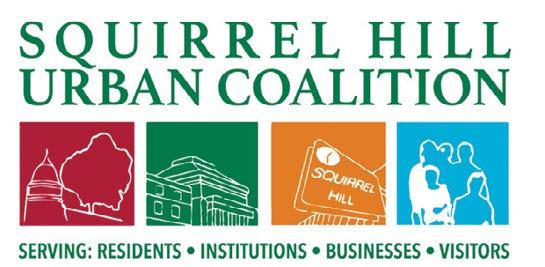
ON THE COVER: ACTION-Housing’s Flats on Forward project is set to open soon.
Credit: Bohlin Cywinski Jackson.
FOR ADVERTISING INQUIRIES
Contact marketing@shuc.org. All other communications can be directed to editor@shuc.org or (412) 422-7666.
As you read this issue, you’ll be amazed by the generous spirit that motivates your Squirrel Hill neighbors to transform houses into homes and streets into communities.
Some people go out of their way to make new residents feel comfortable. Some organizations think strategically about making Squirrel Hill housing more accessible. Many neighbors build enduring bonds through community service and oldfashioned fun.
What makes Squirrel Hill a home for you? I invite you to reflect upon what brought you here and to think about what you might do to welcome others who are now arriving.
MELISSA EPPIHIMER Editor, Squirrel Hill Magazine
SQUIRREL HILL URBAN COALITION OFFICERS
PRESIDENT Mardi Isler
VICE PRESIDENT Dalia Belinkoff
VICE PRESIDENT Erik Wagner
SECRETARY Raymond N. Baum
TREASURER Paul Katz
IMMEDIATE PAST PRESIDENT Richard Feder
BOARD OF DIRECTORS
Raymond N. Baum, Justin Beck, Dalia Belinkoff, Guy Costa, Lori Fitzgerald, Heather Graham, Barbara Grover, Marshall Hershberg, Melissa Hiller, Martha Isler, Paul Katz, Joseph Ott, Jon Prince, Mary Shaw, Lisa Steindel, David Vatz, Erik Wagner
The Squirrel Hill Magazine is a publication produced by the Squirrel Hill Urban Coalition (SHUC), a nonprofit organization. As a non-profit 501(c)(3) organization, donations to SHUC are tax-exempt, and SHUC complies with all 501(c)(3) rules and regulations.
CONTRIBUTORS
Allie Amoaye, Lena Andrews, Luke Chinman, Cole Cohen, Maria Cohen, Melissa Eppihimer, Larry Gerson, Mardi Isler, Todd Miller, Jim Rogal, Helen Wilson
EDITOR Melissa Eppihimer
DESIGNER Karen A. DeTurck
EXECUTIVE DIRECTOR Maria H. Cohen
Squirrel Hill Magazine, Vol. 21, Issue 2, is provided by the Squirrel Hill Urban Coalition as a free service to the residents and businesses in the 15217 zip code. Subscriptions are available for $25/year. No portion of this magazine may be reproduced without permission. Printed by Knepper Press.
Magazine R Vol 21 | Issue 2 Summer|Fall 2023 2 | shuc.org
Helen Wilson

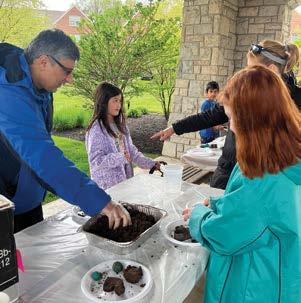
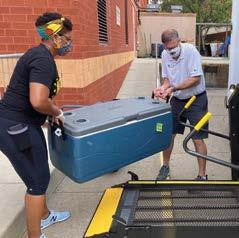



 by Allie Amoaye
by Allie Amoaye
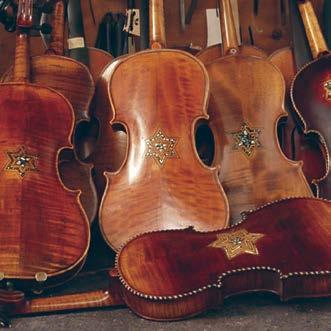 by Luke Chinman
by Luke Chinman

SUMMER|FALL 2023 features in every issue facebook.com/ squirrelhillmagazine twitter.com/ squirrelhillmag instagram.com/ squirrelhillurbancoalition shuc.org/blog 4 12 14 16 28 36 38 40 42 6 20 24 32 33 6 42 36 33 12 GREETINGS FROM THE SHUC PRESIDENT
COMMUNITY CHAMPION: BRIAN SCHREIBER
STATE AND CITY COUNCIL CORNER NEIGHBORHOOD NOTES SHUC SNAPSHOTS GOOD NEWS FROM OUR SCHOOLS YOUTH VOICES
PET POINTS
SQUIRREL HILL HISTORY
CLOSE TO HOME
ACTION-HOUSING
MAKING PITTSBURGH A HOME FOR REFUGEES
ANNOUNCING THE TREASURES VIOLINS OF HOPE
by Mardi Isler
by Jim Rogal
by Cole Cohen
by Lawrence Gerson, VMD
by
by Melissa Eppihimer
by Lena Andrews
Greetings from the SHUC President
By Mardi Isler, SHUC Board President

You may remember that I’ve quoted Charles Montgomery’s book Happy City in previous writings. That’s because I generally find it supports my beliefs about urban living.
As I was considering our theme of “home” for this issue of the magazine, I was reminded of a Montgomery quote that I find apropos. “Happiness is a house with many rooms, but at its core is a hearth around which we gather with family, friends, the community, and sometimes even strangers to find the best part of ourselves.”
I love my house. It is typical of Pittsburgh homes built just after the turn of the century, situated on a sloped narrow lot, with four stories open in the sides and back, three in front. It has had only two major updates, one in 1968 done by German psychiatrists with two sons, meaning European influences such as indirect lighting and removal of seven of the eight fireplaces and most of the gingerbread trim. But they kept the essential stained glass on the first floor and up to the second, plus the arches and the wood floors throughout, and replaced all basement, first, and second floor plumbing and wiring. Their plans came with the house when we purchased it in 1984, even though there had been two other owners in between. Our first necessary restoration was to replace the 80-year-old slate roof and all the windows since few were workable with the original weight and chain systems.
When the second major renovation was done in the early 1990s, I was able to design my kitchen so that it worked for me and to break through to the dining room, move the laundry room to the 2nd floor, add a breakfast area, expand the back deck, and update two of the four bathrooms.

Still, the house is not perfect, and it may not ever face another renovation while I’m living in it. This house, it’s my home, it suits me. Our 3rd floor has two and a half bedrooms and a bath. The largest bedroom shares its space with my Family Tree files, or (actually) boxes of family tree documents that need to be
Brandywine Communities
State Senator Jay Costa
4 | shuc.org
MESSAGE FROM THE PRESIDENT SHUC would like to thank the following sponsors
filed! The half bedroom is my sewing room, which my husband affectionally calls my unfinished projects room. Admittedly, there are many knitting, sewing, and craft projects there that do need to be finished. Well, hopefully someday?
Our front porch affords an opportunity to watch the world go by and not be seen and is a great place to chat. Our front yard is set back far enough from the street that I’ve been able to maintain a garden to my liking, with some full sun areas and some shade. Deadheading and digging in dirt are fun for me. All was right with my entrance until last year when the deer came and decimated every flower and some shrubs and grasses early in the season. My yard was a disaster after that, which saddened me. Following this experience, I found many other residents who were also adversely impacted by the city’s deer overpopulation problem. (See the “Protect our Parks and Gardens” update in this issue’s SHUC Snapshots on pg. 29.)
While I noted that the house isn’t perfect, the location is. There is no commute for me to buy a book at Riverstone, pick up dinner for grandchildren at Silk Elephant or get them a gift at Games Unlimited, find a present for my daughter-in-law at Cheeks, buy shoes and chat with Terry, Gina, and Justin at Little’s. I buy myself flowers almost every week at Squirrel Hill Flower Shop, usually my last stop and where I can have a friendly conversation with Ronna and her daughter Katie. I’ve been going to the latter two places for 39 years—happy stores in my happy city! By shopping locally, I can also maintain social connections,
often running into people I haven’t seen for years or months or since before Covid (!).

When I walk to the Farmers Market, it’s another chance to see my neighbors, my City Council representatives, our friends with new grandchildren or new puppies, and my favorite vendors, Who Cooks for You, Paul’s Orchards, and McElhinney Farm, plus other sellers with good-looking offerings. I pass Mardi’s Urban Forest on Beacon Street, with people sitting, chatting, having lunch—it’s one of the intended happy places for people to find respite, this one provided by one of SHUC’s past treasures, property owner John Katz. SHUC, with government and foundation support, has funded others—O’Connor’s Corner and the Post Office Parklet—and we continue to buy benches and place them at purposeful locations on Forbes and Murray.
I’ve always recognized that if I want my business district to remain vibrant, I need to support it, making purchases from our merchants so they can be profitable and stay in business here. As handy as online is for items unavailable on Forbes, Murray, Forward, Northumberland, or Wilkins, I restrict those purchases to when my retailers can’t meet my need.
Coming back to Montgomery’s quote, his happiness house is not literal, but for me, my house, my home, my happiness house is a physical place. It does give me the opportunity to gather friends and family, to be a part of this wonderful Squirrel Hill neighborhood, to have holiday parties, seasonal corn fests on the deck, and to have a fenced-in yard for our furry family members, giving me what I need to support the joy that I find in my life here.
Yes, it’s a lot of house for two people, but when asked if we are going to downsize, my response is always the same: “I plan to die in this house with my boots on!”
Summer/Fall 2023 | 5
MESSAGE FROM THE PRESIDENT
of the 2023 issues of Squirrel Hill Magazine.
County Controller Corey O’Connor
State Representative
Dan Frankel
City Councilperson
Erika Strassburger
City Councilperson Barb Warwick
This house, it’s my home, it suits me.
Close to Home: Squirrel Hill’s Microneighborhoods
By Melissa Eppihimer
ON THE MAP, SQUIRREL HILL IS PITTSBURGH’S LARGEST NEIGHBORHOOD. It’s large even if you take away Frick and Schenley parks or split it into North and South.
Yet for many who live here, Squirrel Hill does not feel that big. Thanks to the active business district, people run into each other all the time, and events like the Night Market and Farmers Market, like magnets, bring people together.
On a smaller scale, there are many corners of Squirrel Hill that create their own local communities through formal or informal means. While urban topography often defines these microneighborhoods, residents shape their identity and mission. The five microneighborhoods included here represent what they and many other communities can do when they band together.

PRESERVING HISTORY: MURRAY HILL AVENUE
On Murray Hill Avenue, the distinctive stone-block road surface indicates the street’s unity. So too do the posted signs identifying it as a historic district.
Although Squirrel Hill’s history is rich, Murray Hill Avenue is the only historic district recognized by the City of Pittsburgh in the neighborhood. Residents of this street, which stretches between Wilkins and Fifth avenues, find that living in a historic district brings the community together.
“We’re historic with a big ‘H,’” said Karen Oosterhous, “and historic with a small “h” in that there’s also an affinity among the people who lived here previously.” Oosterhous, who has lived on the street for 14 years, knows the former owners of her home and sometimes runs into them in Squirrel Hill.
6 | shuc.org
Murray Hill Avenue residents were actually the ones who pushed for the historic district designation. When in 1969 Chatham University sought to demolish a series of homes to make space for a new library, the avenue’s residents spoke out against the plan. Although their efforts were unsuccessful—see the Jennie King Mellon Library on campus—the neighbors were determined to preserve the street’s historic architecture and special character. By 2000, the Murray Hill Avenue historic district was born.
It’s a concern that continues to occupy the community. Recently, two houses left out of the original historic district legislation were successfully added, and
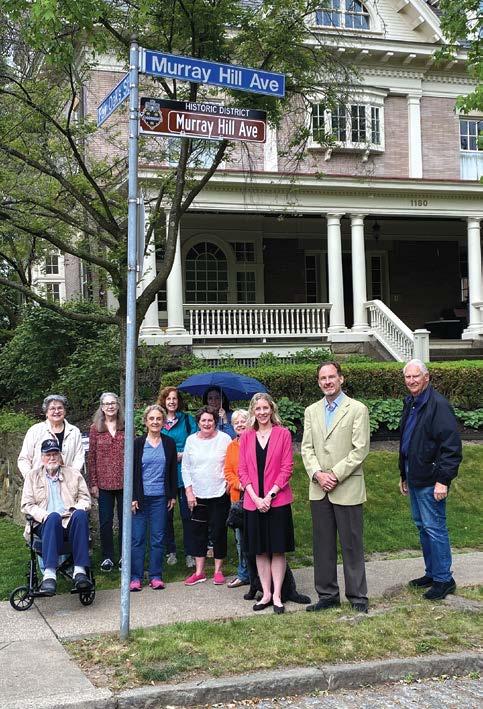
residents remain in dialogue with Chatham and city officials regarding long-term developments. For the residents, the goal is to make sure that houses remain houses, and the street retains its residential character.
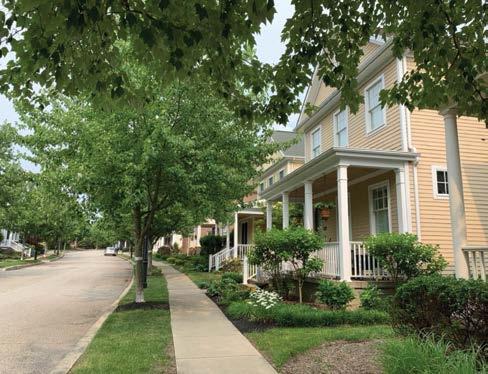
That’s something even the “bumpity-bump” made by vehicles driving over Murray Hill Avenue’s stone blocks can’t disturb.
BUILDING A NEIGHBORHOOD FROM SCRATCH: SUMMERSET AT FRICK PARK
The oldest houses on Murray Hill Avenue are more than 100 years old. The oldest homes in Summerset at Frick Park are barely 20. The transformation of a slag heap from Pittsburgh’s industrial past into a beautiful residential landscape is a remarkable success story, but the community that has grown within it is the best part of the story.
Summer/Fall 2023 | 7
Councilperson Erika Strassburger attends the unveiling of the Historic District sign with residents of Murray Hill Avenue.
This picturesque view of Summerset at Frick Park only hints at the community within.
Photo by Scott McMurtry.
Photo by Helen Wilson, 2023.
There’s Food Truck Thursdays, when a rotating schedule of food trucks roll into the neighborhood. There’s the garden club that collaborates to maintain a community garden. There’s the heartfelt retirement party for the mail carrier, a man so beloved that multiple people approached Marie Stapinski, President of the Summerset Neighborhood Association (SNA), thinking that they would host a party. “We ended up consolidating the party scene and threw a grand blowout for him in the Community Center,” said Stapinski. “I could go on and on about what it means for me to live here,” she emphasized.

As President of the SNA, which is officially a homeowners’ association, Stapinski deals with everything from traffic worries to financial statements, with a dose of individual homeowner concerns thrown in the mix. “The diversity of our community often leads to diverging needs. Our retirement community has different needs than the young families,” she said.
Whatever the challenges may be, the SNA and the residents at Summerset have figured out how to make it work.
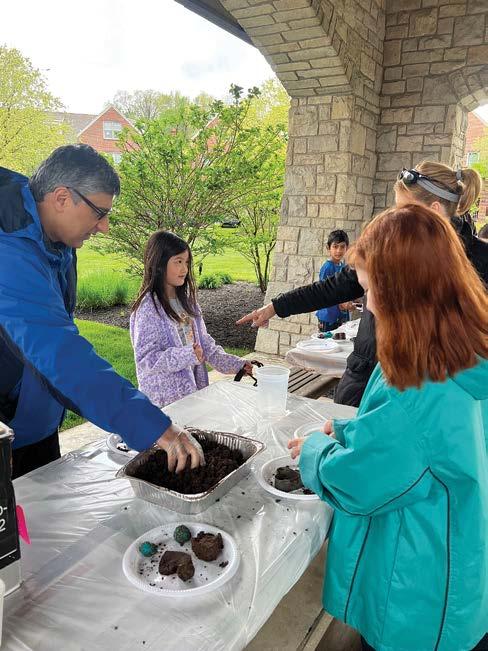
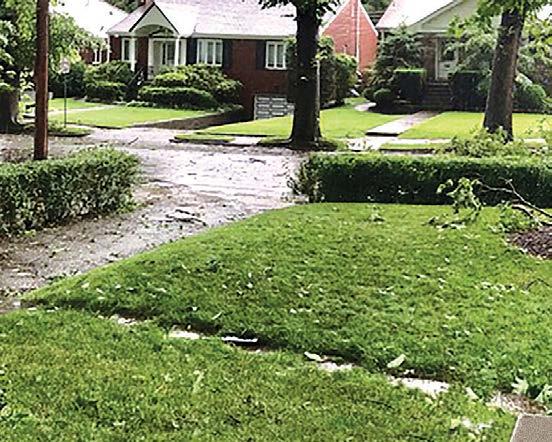
8 | shuc.org
After a microburst damaged trees and homes on Solway Street, neighbors came up with temporary and long-term solutions.
An Earth Day event at Summerset at Frick Park taught composting techniques to residents of all ages.
Food Truck Thursdays bring Summerset at Frick Park’s residents out for impromptu communal picnics.
SUPPORTING EACH OTHER: SOLWAY STREET
When a violent thunderstorm in June 2021 toppled one of Solway Street’s large trees onto and through the roof of a house, some dozen neighbors grabbed towels and tarps and rushed over to see how they might be useful.

According to Jacquelyn Cynkar, this is typical for the 5800 block of Solway Street. “In these kinds of moments, the authenticity of the street and its residents is palpable and reassuring. There’s a deep trust in one another,” she said.
The neighbors’ immediate response to this crisis was borne out of bonds built during block parties, casual music events, and even dog-walking conversations.
In recent years, the block’s sense of community has been called upon in multiple moments of crisis. Before the storm there was, of course, the pandemic, when neighbors created a porch pantry to deposit food for those in need, close by or further away.
Before that, the shooting at the Tree of Life synagogue building, which is adjacent to the backyards of some houses on the north side of the street, brought neighbors together in grief. One evening, Stefani Pashman and Jeremy Feinstein opened their home for people from the block to be together and process the shocking and tragic events that had just occurred.
Nowadays, a walk down the 5800 block of Solway is a bit different than it was a few years ago. Many of the colossal trees have been replaced with young saplings. This decision came about after Councilperson Erika Strassburger helped coordinate multiple visits from Lisa Ceoffee, City Forester, during which residents learned about the condition and risk of each street tree on the block and shared their own perspectives.
If the way they treat each other is any indication of how 5800 Solway’s residents will treat the new trees, future residents will enjoy their shade for decades to come.
Summer/Fall 2023 | 9
KEEPING IT SMALL: FERREE STREET
Murray; Shady; Beechwood. These thoroughfares stretch nearly the whole length of Squirrel Hill and for many are the neighborhood’s signature spaces.
But Squirrel Hill also has its share of short streets that aren’t so familiar. Consider Ferree Street, which branches off Murray Avenue for just a block before ending at Asbury Place, another small street. Ferree is perhaps most noteworthy for being a real yellow brick road.
Since at least the 1990s, Ferree Street has held an annual block party for its residents, and often those of Asbury Place as well. It’s hard to know whether the tradition persists because of or in spite of the street’s small size.
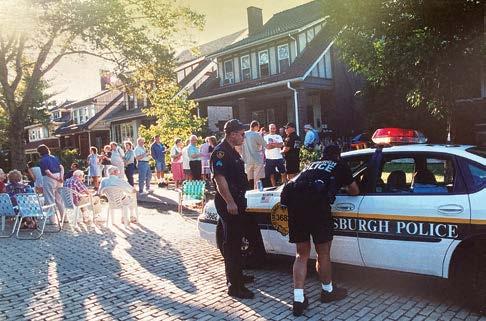

Usually held in a courtyard formed by townhouses, the block party allows neighbors to catch up, welcome newcomers, and, when the event coincides with the National Night Out in August, get to know some of the police and fire personnel that work out of the Northumberland Street stations around the corner.
Rosa Barnett Averbach lived on Ferree Street for 42 years before recently downsizing in Shadyside. She remembers how the block party always managed to happen even without a formal neighborhood association on the street.
Both the city and the weather seem to cooperate as well. “Luckily, the rain was usually at the end of the event,” said Averbach, “and the trash collection was the next day.”
HAVING FUN WHILE HELPING: MT. ROYAL ROAD
Like Ferree Street, the neighbors on and around Mt. Royal Road enjoy getting together. They swap contractor recommendations and share stories during pop-up Happy Hours and semi-annual block parties.
In recent years, they’ve made sure their social gatherings benefit others as well. The COVID-19 pandemic inspired the Mt. Royal neighbors to sponsor a food drive, collecting ingredients that could be used to make complete meals. They’ve also gathered personal
10 | shuc.org
Neighbors become friends at block parties like this one on Ferree Street.
During 2002’s block party, Ferree Street residents mingled with police officers from the nearby station.
hygiene items for Steel City Helping Hands and fun things for the Hazelwood Initiative’s Safe Halloween goodie bags.
“These neighborhood drives are a chance to make a small-dollar donation that individually seems too small to make a difference but added together with your neighbors really does make a difference in many people’s lives,” said Tim Joyce, who is part of the Mt. Royal community.

Mt. Royal’s spirit of collaboration and service has deep roots in the Nine Mile Run Greenway. What had once been an overgrown, trash-filled hillside is now a parklet where neighbors walk their dogs, hike, and enjoy nature. Although the City of Pittsburgh helped on the bureaucratic side, with City Council officially approving it in 2012, community members provided much of the time, effort, and money required to reclaim the land for public usage.
But Mt. Royal neighbors also won’t let their achievements overshadow how much they enjoy each other’s company. “We just like to party with each other,” said Evelyn Castillo, one of the group. What’s better than fun with a net-positive outcome?
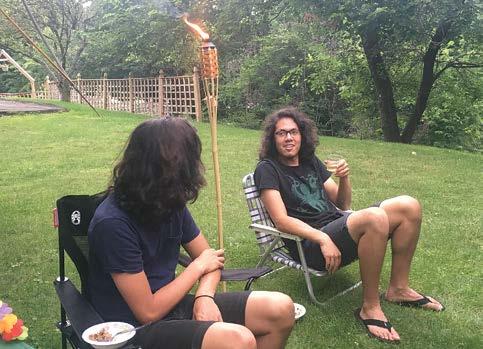
DOES YOUR CORNER OF SQUIRREL HILL HAVE ANY SPECIAL TRADITIONS OR COMMUNITY ACTIVITIES THAT YOU’D LIKE TO SHARE? SEND STORIES AND PHOTOS TO EDITOR@SHUC.
ORG AND IT MAY BE FEATURED IN A FUTURE MAGAZINE ISSUE OR SHUC NEWSLETTER.
 The Nine Mile Run Greenway hosts social gatherings that take advantage of its natural setting.
The Nine Mile Run Greenway hosts social gatherings that take advantage of its natural setting.
Summer/Fall 2023 | 11
Mt. Royal Road neighbors collected ingredients for tacos in one of their food drives.
Brian Schreiber Community Champion:
By Jim Rogal
IS THERE ANYTHING THAT REPRESENTS THE HEART OF A COMMUNITY MORE THAN A COMMUNITY CENTER? Well, in the heart of Squirrel Hill sits the Jewish Community Center (JCC). And at the heart of the JCC is President and CEO Brian Schreiber.

“Servicing this entire community is our day-to-day delivery,” he said. “Our governance is Jewish, but our service is to the community at large.”
Need proof? Just read the JCC’s commitment to inclusion and diversity posted in the building:
“The JCC is open and accessible to everyone, regardless of age, race, religion, national origin, sexual orientation, gender identity, gender expression or special need by welcoming individuals of all backgrounds, embracing their uniqueness and diversity under our communal tent.”
It’s Brian Schreiber’s job to live that commitment every day, which he does passionately, and with good reason.
“We are on the second busiest bus line in the city, and we are fully ensconced in this community,” he said. “This is an urban neighborhood with an urban school system and urban residents, and we embrace what it means to be part of our community.”
Schreiber describes the JCC as “the go-to place for community engagement. We are the community’s gathering place, and the people of this community are used to collecting here.”
The JCC already is a partner in one form or another with most every business, organization, nonprofit, and enterprise in Squirrel Hill—and beyond.
“We feel a responsibility not just to Forbes and Murray, but to the whole city,” Schreiber said. “We open up our space to community meetings, town halls, organizational gatherings, whatever; we are open to all meetings.”
Spoken like a true Pittsburgher, which he most definitely now is. But Schreiber didn’t grow up here. He was born in Newark, N.J., and raised in Philadelphia. After working for Jewish organizations in Israel and in Baltimore, Schreiber came here in 1992 to work for the Jewish Federation of Greater Pittsburgh. He began his
12 | shuc.org
Photo courtesy of JCC of Greater Pittsburgh
current job at the JCC in 1999 because “I wanted to be involved in more direct service to people,” he said. And he brought with him a view of his adopted city that remains intact today.
“The qualities of the people who live in Pittsburgh are extraordinary,” he said. “There’s a sense of safety and hominess here that is palpable.”
So is the tradition of passing it on. “There’s a legacy of oral history here,” Schreiber said. “One of the beauties of Pittsburgh is a collective pride in the historical nature of our institutions.”
The JCC is a perfect example. It was founded more than a century ago as the Irene Kaufman Settlement, an agency dedicated to serving Pittsburgh’s immigrants. Over the years and in several locations, it has evolved into today’s JCC, “a fully accomplished community center,” as Schreiber put it.
“When I got here it was already apparent that this agency was a treasure to the community,” he said. “We’ve doubled the scope of who we serve since 1999, and our budget is two and a half times what it was then.”
That mission of providing service will continue into the future. The JCC’s path, as Schreiber sees it, “involves even more inclusiveness and a broader focus. There’s a huge landscape of where this community is and where it’s going.”


One idea being talked about now—providing medical services. “It would be great to incorporate a wellness center here, perhaps provide offices for medical practices,” he said. So, stay tuned.
It’s been the hallmark of the JCC itself from day one, and Schreiber still embraces it today: “The definition of a neighbor is not a geographic measurement, but a moral commitment.”
Summer/Fall 2023 | 13
“We feel a responsibility not just to Forbes and Murray, but to the whole city.”
Photo courtesy of JCC of Greater Pittsburgh
State and City Council Corner
State and City Council Corner shares reports submitted by the elected members of Pittsburgh City Council and the Pennsylvania Legislature that represent Squirrel Hill.
FROM STATE REPRESENTATIVE DAN FRANKEL
There are no risk-free levels of exposure to secondhand smoke. In 2006, the U.S. Surgeon General’s report concluded that breathing in secondhand smoke— even for a moment—poses a risk to an individual’s health. Yet still, Pennsylvania workers are forced to inhale smoke in casinos, private clubs, and some drinking establishments because of loopholes in Pennsylvania’s Clean Indoor Air Act that permit smoking inside these establishments.
State Representative Dan Frankel is re-introducing legislation to close the Clean Indoor Air Act loopholes. The Protecting Workers from Secondhand Smoke Act will ban smoking in casinos, private clubs, and bars. The ban would not include personal residences or vehicles or businesses where tobacco consumption is the primary business, including hookah lounges and cigar bars.

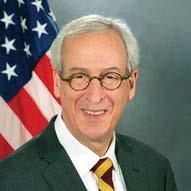
FROM STATE SENATOR JAY COSTA
The Long-term Owner Occupant Tax Exemption Program (LOOP) bill passed out of the Housing and Community Development Committee in the House of Representatives unanimously. Representative Sara Innamorato and Senator Costa are excited this bill is on its way to becoming law.
As development pressures increase in certain neighborhoods, longtime owneroccupants are at risk of being forced out of their homes due to rapid jumps in property taxes.
Given increasing tax burdens where property values have quickly risen, Senator Costa is fighting for amendments to the “First and Second Class County Property Tax Relief Act” to allow the City of Pittsburgh to offer property tax breaks to longtime owner-occupants of residences to remain in peaceful possession of their homes.
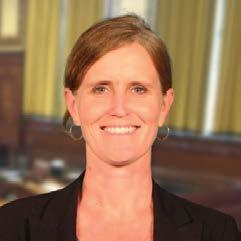
The people who built our communities belong in those communities. It’s up to the legislature to ensure that long-term members of communities can afford to stay in the homes they love.

14 | shuc.org
From Top to Bottom: State Representative Dan Frankel; State Senator Jay Costa; City Councilperson Erika Strassburger; City Councilperson Barb Warwick.
FROM CITY COUNCILPERSON ERIKA STRASSBURGER
In the spring, Mayor Gainey’s administration announced their proposal to delay the implementation date of last year’s single-use plastic bag ban until October. Amendments to the original bill were adopted at the request of the administration in order to ensure a successful rollout of the initiative.
Notable changes include:
• Moving the enforcement date from April 14 to October 14 and requiring businesses to post visible notices of the upcoming single-use plastic bag ban 90 days before implementation
• Adding a requirement that the City launch a webpage dedicated to providing public information on the policy
• Directing DPW to cultivate and share lists of distributors for both compliant bags
• Creating a three-step sanctions framework whereby inspectors can issue written warnings for initial violations which would then be followed by escalating fines

Councilperson Strassburger is confident that by October, DPW will have the requisite personnel to launch and implement the policy.
FROM CITY COUNCILMEMBER BARB WARWICK
With summer comes a renewed focus on our parks and green spaces across the City.
In late 2022, the Pittsburgh Parks Conservancy (PPC) received a grant to clean up, remove invasive plants from, and “goatscape” Hays Woods over the next 18 months. The District 5 City Council team was lucky enough to recently take a tour of the area and appreciate some of the work being done there. It’s a beautiful place for a hike, with forests, meadows, and views all the way to Oakland.
The District 5 office has also been attending discussions about the design of an accessible outdoor classroom at the Frick Environmental Center. The PPC, the City of Pittsburgh, community organizations, and other stakeholders are working to create a series of sensory experiences organized along an accessible route through the space’s natural landscape. Designs for the classroom should be finished by the end of the summer.
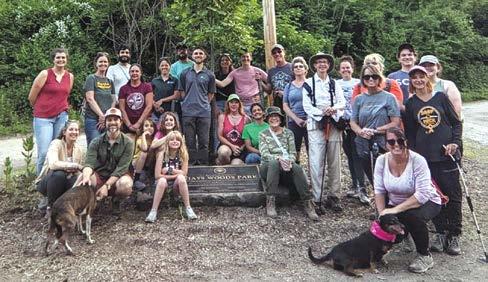
Summer/Fall 2023 | 15
Hays Woods hike with City Councilmember Warwick and the Pittsburgh Parks Conservancy on May 30, 2023.
NEW BUSINESS NOTICES

PAPELON BISTRO VENEZUELAN AREPAS BAR
In Venezuela, arepas are a common evening snack after a night out on the town. This dining culture, explained Leonardo Peña and Armando Gonzalez, brothers and co-owners of Papelon Bistro (1923 Murray Ave), was the inspiration for the casual lunch and dinner spot they opened in May, which serves a variety of versions of the stuffed dough dish—among other Venezuelan fare.
After moving to the United States from Venezuela a few years ago, the pair have been busy in the kitchen, selling an array of baked goods at farmers markets around the city and getting their name out in Pittsburgh’s Venezuelan community. At their newly opened storefront in Squirrel Hill, they offer arepas made with your choice of shredded beef or chicken, roasted pork, black beans, avocado, and cheese. As an alternative, opt for pabellón, a Venezuelan bowl dish with beans, rice, and a selection of mix-ins.
According to Gonzalez, “Arepa is going to be the next taco.” The brothers are thrilled to bring their culinary creations to the neighborhood and dream of opening more restaurants all over the city as Venezuelan cuisine becomes the next big thing.
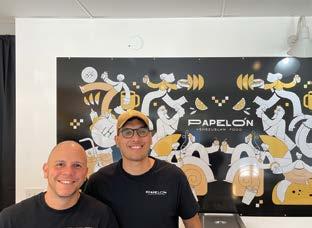
YOGA FACTORY
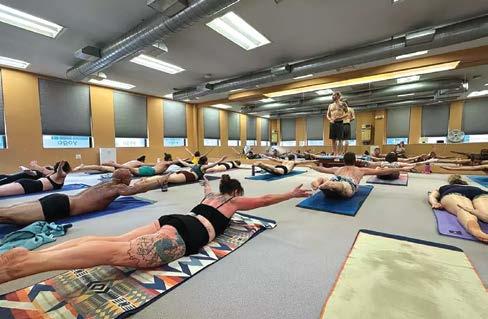
On an upper floor at the corner of Forbes and Murray, you’ll find your neighbors squatting, stretching, and sweating in one of the numerous classes offered every week by Yoga Factory (1701 Murray Ave). After nearly 15 years in Lawrenceville, one of Pittsburgh’s yoga staples
has opened another location in Squirrel Hill. With 50 classes and 15 instructors across their two locations, Yoga Factory offers something for everyone: classic hot yoga flows, the traditional vinyasa and ashtanga yoga, and yin yoga for a more relaxed session. They also hold roughly two yoga retreats every year, regularly host guest instructors, and put on sound healing workshops— all “ways for students to deepen their yoga education,” according to co-owner Angelica Daniele.
Daniele welcomes anyone to enter the yoga studio, whether you’re a yoga newbie or a pro. “We are open to all bodies,” she said. “We highly encourage everybody to sign up for the introductory month, try out all of the class options that we offer, and start your yoga journey.”
LOOK EYE CARE
If you’re searching for your next pair of eyewear, you’re in luck. After spending the last few years looking for a storefront, the family-owned glasses shop Look Eye Care, which first opened their doors at Ross Park Mall in 2019, has cut the ribbon on a new location in Squirrel Hill (5831 Forbes Ave).
As soon as you enter, you are immediately surrounded by luxury—designer glasses from Gucci, Saint Laurent, Burberry, and many more line the walls and fill
16 | shuc.org
NEIGHBORHOOD NOTES
cases throughout the store. But beyond the diverse brand selection, Look Eye Care also offers eyeglass adjustments and eye exams for interested customers. A host to medical and fashion expertise, it’s a one-stop shop for your vision needs.
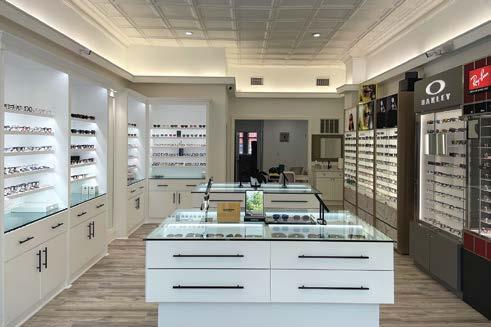
Manager Shawn Goldman said that, above everything, Look Eye Care’s individualized service sets them apart from other eyeglass stores. As a small operation, each customer can receive the help they need to find their perfect pair.
SUCCESSFUL STAINED GLASS TOUR AT BETH SHALOM

The next time any of the more than 50 people who attended the joint program of the Squirrel Hill Historical Society (SHHS) and Congregation Beth Shalom (CBS) on June 4 pass by the building’s magnificent stained-glass windows or pray in the sanctuary, they will know the stories told in glass. That’s because, on that early June afternoon, Barbara Oleinick, a longtime CBS congregant who has become an authority on the windows by conducting extensive research over the past 25 years, shared her knowledge with the group in a presentation titled “A Colorful History of the Stained Glass Windows at Congregation Beth Shalom.”
The first set of six windows were created in 1931 by Pittsburgh Stained Glass Studios (located in the West End) in collaboration with the building’s architect, Alexander Sharove when CBS expanded the initial building at the corner of Beacon Street and Shady Avenue. To meet CBS’s growing needs, the congregation undertook another building expansion in 1969 that was completed the following year and included six more stained glass windows created by PSGS.
Themes on the windows include The Ten Commandments; Life Cycle Events; the High Holy Days; the major festivals of Passover (escape from slavery in Egypt), Sukkot (celebration of the harvest) and Shavuot (giving of the Torah); the Holocaust; the State of Israel’s founding in 1948; and the reunification of Jerusalem following the Six-Day War in 1967.
When asked whether she plans to publish her research findings, Oleinick replied, “Maybe someday, but there is so much more to learn.”
To watch a recording of the program, visit the SHHS website at https://squirrelhillhistory.org/2023-2/

Summer/Fall 2023 | 17 NEIGHBORHOOD NOTES
Photo by Helen Wilson, 2023.
DESIGNING IN SQUIRREL HILL


With this issue of the magazine focused on homes, it seemed like a good opportunity to check in with the team at Evelyn James Interiors (5870 Forbes Ave).

The old age of many Squirrel Hill homes makes redesigning their interiors difficult, but Wedner and Checkeye are always up for the challenge. “People appreciate the old, crafted homes with certain features, but the question is how to deal with them?” said Checkeye. Whether it’s maneuvering furniture around tight staircases or carving out open living spaces in closed-off quarters, there are usually solutions. “We want to allow the home to continue on,” said Checkeye.
SUMMER FUN CONTINUES
If you’ve not yet had a chance to participate in some of the East End’s most beloved summer traditions, there are still plenty of opportunities to join your neighbors at the Squirrel Hill Farmers Market and the Night Markets on Murray Avenue.

First, you should know that “Evelyn James” is not one person, but a pair of design experts who lend their first names to their interior design business. Evelyn Wedner and James Checkeye have been working out of their Forbes Avenue storefront since 2004. Both designers used to work for the Arthur Moser store across the street, but when it closed, they realized that their skills might still be valued in the community. “We knew the neighborhood,” said Checkeye, and Wedner grew up and still lives here.
Both Checkeye and Wedner approach the design process with an eye—and an ear—towards making the home work for the clients that live there. “Our goal is to make your ideas a reality,” insists Wedner. But clients can also count on their ability to see things in a different way or to offer new ideas. “Our clients share their color palette, but we push it to the next level,” Wedner said.
The Farmers Market continues every Sunday from 9 am to 1 pm well into November. The vendors’ offerings are more diverse and delectable than ever before, with lots of home-grown or home-cooked foods to enjoy, plus fresh flowers, composting services, distilled spirits, and children’s clothing. Chances are, you’ll return week after week to stock up and try a few more things.
If you’d rather meet your friends and neighbors in the evening, come to Murray Avenue on Saturday, August 24 and Saturday, October 7 for the second and third Night Markets of the season. From 6 to 10 pm, more than 75 I Made It Market! vendors will display their creations; restaurants and food trucks will offer food and refreshments; and performances will entertain you as you stroll down a pedestrianized thoroughfare.
18 | shuc.org
NEIGHBORHOOD NOTES
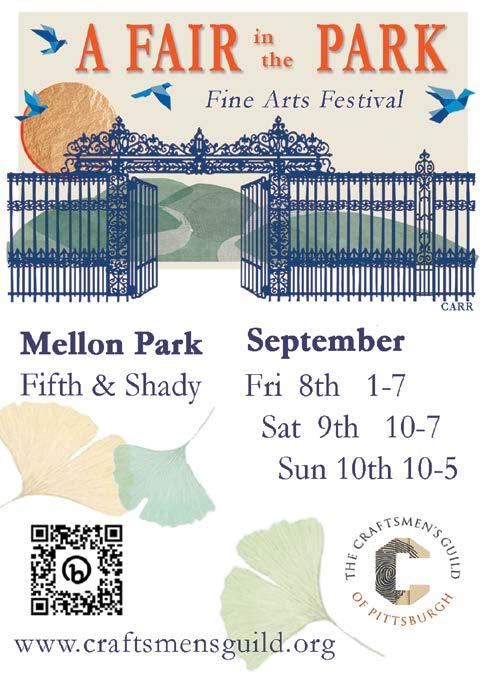


ACTION-Housing: Building Affordable Homes in Squirrel Hill
 By Lena Andrews, Vice President of Real Estate Development, ACTION-Housing
By Lena Andrews, Vice President of Real Estate Development, ACTION-Housing
IF YOU GREW UP IN THE EAST END AND WENT ON A LOT OF ROAD TRIPS, YOU MAY GET A WARM AND NOSTALGIC FEELING WHEN YOU EXIT 376 AT THE SQUIRREL HILL EXIT—THE FEELING OF COMING HOME Squirrel Hill is a neighborhood that anyone would want to call home. It is walkable, it has beautiful and varied architecture, it has thriving business and residential districts, it has beautiful parks, it has transit, and it is green. Most importantly, it is a warm and welcoming community. To all this, ACTION-Housing has been working to add the kinds of affordable housing options that will grow and enhance this community.
ACTION-Housing was founded in 1957 by philanthropist Richard King Mellon and Pittsburgh Mayor David L. Lawrence. Our mission is to create affordable housing where people can thrive. We build housing, but our goal is to build lives. We have been privileged to partner for decades with local organizations like the Squirrel Hill Urban Coalition and The Branch (formerly known as Jewish Residential Services) to build/renovate four apartment complexes in Squirrel Hill, all of which have units for people with disabilities. We own and operate three of these buildings, and the fourth—Flats on Forward—will be opening in the summer of 2023. We are increasing our investment in the neighborhood by opening an ACTION-Housing office on the first floor of Flats on Forward so that our employees can be based in this wonderful neighborhood.
CHARLES MORRIS HALL AND JASON KRAMER HALL
We started our work in Squirrel Hill in 1999 with two properties that were renovated in partnership with The Branch. The Branch identified a significant need in the community for housing for people with disabilities and brought in ACTION to purchase and renovate two apartment buildings exclusively for people with mental health and/ or intellectual disabilities.
20 | shuc.org
Charles Morris Hall, a building renovated by ACTION-Housing, hosts 12 apartments.
The Branch staff provides the supportive services for the buildings, making sure the residents have the tools they need to live independently. Many of our residents have connections in Squirrel Hill, and because of these buildings they have been able to live on their own while staying close to family and friends. Charles Morris Hall on Munhall Road has 12 apartments; Jason Kramer Hall on Darlington Road has 10 units. Both are within walking distance of the Murray Avenue commercial district. Charles Morris Hall is named after a donor who helped to make the purchase and renovation of the building possible. Jason Kramer Hall is named after one of its original residents; his family made a donation to the project in his memory.
We continue to invest in both buildings. We have raised new funding from the Urban Redevelopment Authority, The Branch, and the Edith Trees Foundation to make capital improvements. A generous benefactor worked with us to plant a new garden in front of Jason Kramer Hall. The Branch recently hosted their annual Passover seder in Charles Morris Hall’s renovated dining room. Residents love the renovations; one person shared that that the refreshed community room “looks and smells great.”
KRAUSE COMMONS
Krause Commons, located at 2609 Murray Avenue, came out of years of planning that was spearheaded by the Squirrel Hill Urban Coalition. Starting with the 2009 Gateway Plan, the community had been working for decades to revitalize the five-way intersection of Pocusset, Murray, and Forward—the Gateway to Squirrel Hill. After Poli’s restaurant closed unexpectedly in 2005, ACTION-Housing was able to acquire the site, in 2014. In May of 2015, a major fire in the adjacent property necessitated the immediate demolition of Poli’s, and we started construction on new affordable housing in this location in 2016.
The building, identifiable by its curved red façade, was completed in 2018. The first floor is home to the brandnew Sally and Howard Levin Clubhouse, which provides recovery-oriented, psychiatric rehabilitation services to people with mental illness, and the second floor houses new administrative offices for The Branch. The upper four floors are 33 affordable one- and two-bedroom units, half of which have a preference for people with disabilities. On the day that we began accepting applications for Krause Commons, we received hundreds of applications for the 33 apartments.
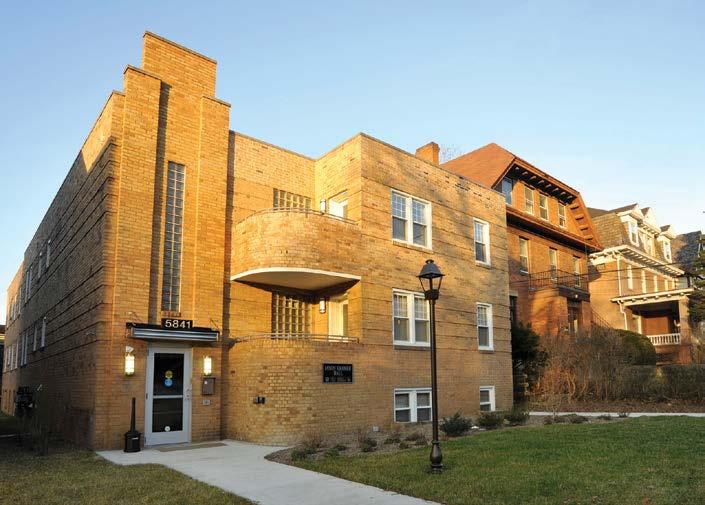
Summer/Fall 2023 | 21
Jason Kramer Hall on Darlington Road is named after one of its original residents.
We’ve received a lot of positive feedback from residents—one resident recently shared that they love the location and want to live in Krause Commons forever.

As a reference to Squirrel Hill’s past, the entrance to the apartment lobby has a pair of golden lobster door handles that are exact replicas of the ones that were used to enter Poli’s. Where generations of Pittsburghers once grasped a lobster on their way to a seafood dinner, Krause Commons’ residents can now do the same on their way home.
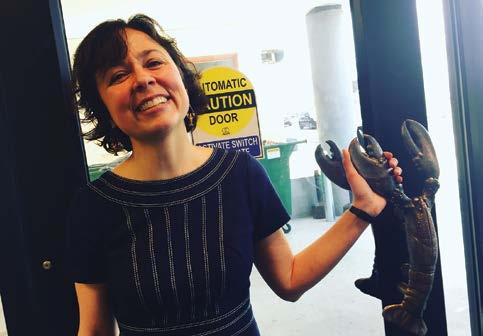
Among Krause Commons’ tenants are the Sally and Howard Levin Clubhouse, The Branch’s administrative offices, and the residents of its 33 affordable apartments.
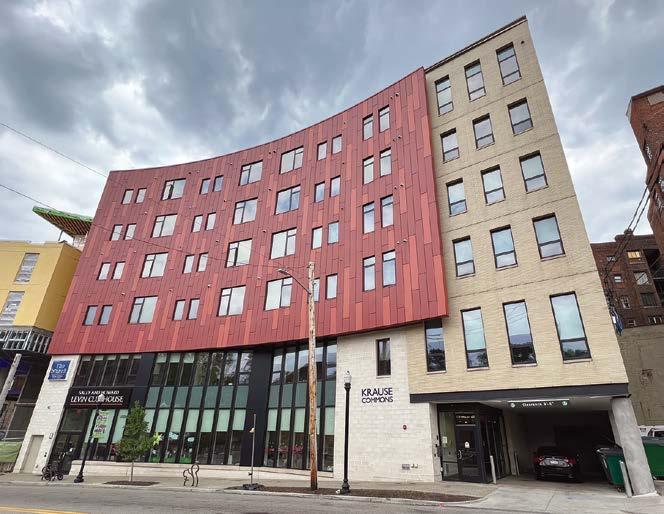 The lobster door handles at Krause Commons are a nod to the legacy of Poli’s restaurant, the previous occupant of the site.
Tenants of ACTION-Housing’s residential complexes thrive in Squirrel Hill.
The lobster door handles at Krause Commons are a nod to the legacy of Poli’s restaurant, the previous occupant of the site.
Tenants of ACTION-Housing’s residential complexes thrive in Squirrel Hill.
Our mission is to create affordable housing where people can thrive.
22 | shuc.org
FLATS ON FORWARD
Flats on Forward, a $26M development located next door to Krause Commons on the site of the former Squirrel Hill Theater, is our most recent investment in Squirrel Hill. It is the largest development project that ACTION has undertaken in its 65-year history and is home to 43 affordable one- and twobedroom apartments. The first floor has 10,000 SF of office space where ACTION will be moving its property management company, Supportive Housing Management Services. The first-floor office has high ceilings and a glass façade—conference rooms in the front of the space are visible from Forward Avenue, bringing new activity to the street.
This project will be completed in the summer of 2023, with residents moving in in the beginning of August. On the first day that we accepted applications

for this project, we received interest from over a hundred people, showing the need for affordable housing in Squirrel Hill and the strong draw of the neighborhood.
Once Flats on Forward is open, ACTION-Housing will have created 98 affordable apartments in Squirrel Hill, but more importantly, we will have created 98 places for people to call home. At the public meetings for Krause Commons and Flats on Forward, many Squirrel Hill residents stood up to speak in support of the project and in favor of building housing for lowincome people and people with disabilities in their neighborhood. It makes a strong statement to have affordable housing at the gateway to Squirrel Hill, showing that we are an inclusive community, and that everyone is welcome here.
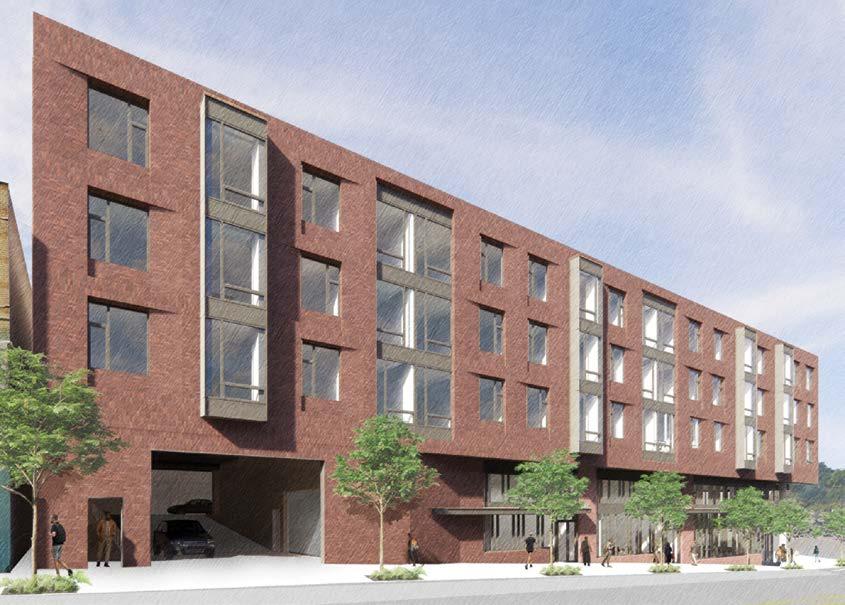
Summer/Fall 2023 | 23
Credit: Bohlin Cywinski Jackson.
A design rendering of the Forward Avenue façade of Flats on Forward, ACTION-Housing’s newest project.
Making Pittsburgh a Home for Refugees: JFCS Partners With Local Groups
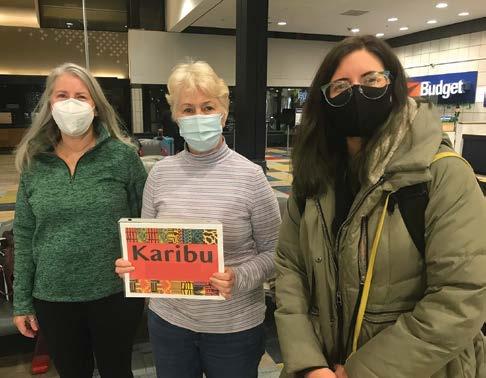
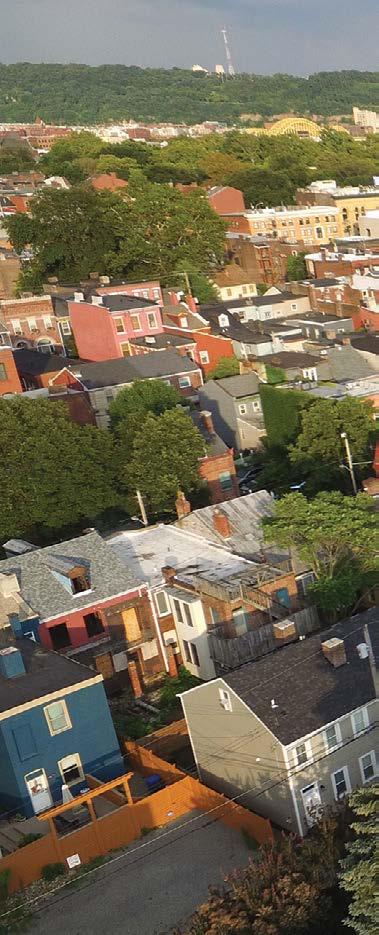 By Allie Amoaye, Public Relations Specialist, JFCS
By Allie Amoaye, Public Relations Specialist, JFCS
WHAT DOES “HOME” MEAN TO A REFUGEE WHO HAS HAD TO LEAVE THEIR HOUSE, PRECIOUS BELONGINGS, COMMUNITY, CULTURE, AND SOMETIMES EVEN FAMILY AND FRIENDS BEHIND? How do you create a home in a new city where you don’t speak the language, don’t know the culture, and don’t know anyone outside the four walls of your house?
Every year, Jewish Family and Community Services (JFCS) helps 200 to 300 refugees arriving in Pittsburgh begin to rebuild their lives and make our city their new home. In the last year, the number of refugees coming to the US has increased, leading organizations like JFCS to adopt a community sponsorship model for some of their new arrivals. Through this collaborative program, local congregations partner with JFCS to help with the resettlement of a refugee family, including finding housing, enrolling in educational programs and school,
24 | shuc.org
Members of Oakmont Presbyterian await the arrival of a family at the airport with JFCS Refugee Sponsorship Coordinator Alina Harbourne (right).
and providing cultural orientation. This model of resettlement not only helps resettlement agencies increase their ability to help refugee arrivals but also provides a community for these refugees to be able to create a new home for themselves in the city.

JFCS currently partners with seven congregations in the Greater Pittsburgh region, including Dor Hadash and Temple Sinai (in collaboration with Shadyside Presbyterian Church) in Squirrel Hill. Alina Harbourne, Refugee Sponsorship Coordinator, explains the importance of a collaborative program like this, saying, “Resettlement is tough, but it’s easier when community members work together to welcome newcomers. My favorite part of my job is seeing co-sponsorship groups
and newcomers from around the world build new bonds and work towards their goals together.”
Ann Pauley, a member from Shadyside Presbyterian, emphasizes that the collaborative nature of the program appealed to the church community. “We thought [being a sponsor] was something that we could do and also an opportunity to work within our community in a way that would forge deeper relationships, not only among the members of our church, but also with an organization like JFCS and with the families we worked with.” The partnership between Temple Sinai and Shadyside Presbyterian has so far aided two refugee families. They are eager to begin again with a new family in the fall. “I think one reason we want to
Summer/Fall 2023 | 25
continue is we can’t imagine not having the relationship with Temple Sinai,” said Ann.
Westminster Presbyterian Church’s sponsorship group in Upper Saint Clair has also worked with two families. After the family they were paired with initially in April 2022 relocated to New England to be near relatives, the group was newly matched with a family of seven from Syria in September 2022. Group member Sandy Conley remembers the day they first met the family. “I’ll always treasure the moment in the family’s front yard when the mother gazed at their new home with tears in her eyes and hugged and kissed both of my cheeks, saying ‘Thank you’ in English,” Sandy said.
The experience wasn’t without its challenges, though, as the family had several barriers to navigating life in the US, especially with little knowledge of the English language. But amid the challenges, the family has also had

many successes, with the support of the Westminster sponsorship group along the way. The members hope and believe that the work they are doing with the family has made a positive impact on the family’s success here in Pittsburgh and know it has changed the members of their congregation for the better.
The experience has helped create a welcoming home for the Syrian family here in Pittsburgh while also expanding the meaning of “home” for the church members involved. Sandy explained, “Hospitality is prized and practiced by this family. Each visit in their home either starts or ends with Turkish coffee, a generous helping of homemade pastries, and conversations aided by Google Translate. Sipping the hot coffee, conversing, and savoring the ‘sweet’ of the day with our new friends is a pure joy.”
26 | shuc.org
This home for newly arrived refugees was lovingly prepared by community members.
When we left our home, we left our friends and family. And we miss all of them very much. But we have found new friends and family here in Pittsburgh.
Another Westminster member, John Van Cleve, reminisced about an unforgettable conversation with the family after an otherwise mundane interaction dealing with day-to-day resettlement tasks. “After finishing whatever we had come to do, I asked the interpreter to [tell] the family that I wanted to thank them, that everyone in the group has benefited from the experience and our church community has been changed for the better,” John said. The father’s response, John recalls, is one that he’ll always remember. He told John through an interpreter, “When we left our home, we left our friends and family. And we miss all of them very much. But we have found new friends and family here in Pittsburgh.”
Alina Harbourne of JFCS expressed that the groups have taken ownership of creating welcoming spaces for the families in their new apartments and houses, adding personal touches and details that they think will help the families feel more at home. With acts like these, the sponsorship groups have made successful transitions for these families happen at a much faster rate. “The groups and sponsored clients have really impressed me with their warm hearts and dedication,” she said.

For JFCS, the community sponsorship groups have been an important and integral part of helping to expand their resettlement services and help Pittsburgh feel like home to refugees. Ivonne Smith-Tapia, Director of JFCS Refugee and Immigrant Services, said, “When a group of individuals comes together to sponsor a refugee family, there is a sense of long-term support that increases feelings of belonging and connection, not only for refugee families but also for sponsors.” She continued, “The benefits of feeling supported and welcomed by JFCS staff members and co-sponsors in their new communities help refugees increase their well-being and feel more confident in continuing their lives as Pittsburghers.”
What would make a new city and culture feel like home to you? If you want to help refugees continue to make Pittsburgh their home, JFCS has many opportunities for individuals, groups, and congregations to get involved in the resettlement process. Find out more by emailing aharbourne@jfcspgh.org.
 The JFCS’ refugee resettlement program held a workshop at the JCC in Squirrel Hill.
The JFCS’ refugee resettlement program held a workshop at the JCC in Squirrel Hill.
Summer/Fall 2023 | 27
NOTES FROM YOUR SQUIRREL HILL URBAN COALITION STAFF
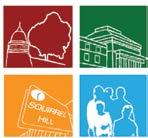
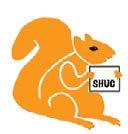
An Update from SHUC Executive Director, Maria Cohen

SUMMER IS HERE, AND I HOPE YOU ARE ENJOYING ALL THE FUN OUTDOOR ACTIVITIES THE SEASON OFFERS! This summer we have been back to our full event schedules for Bach, Beethoven, and Brunch, our Squirrel Hill Night Markets, Farmers Markets, and the Vintage Grand Prix. There is a vibrant buzz throughout the East End and our city! And maybe you’ve noticed a quieter feature adding to the ambiance: the new planters on Forbes and Murray! A special thank you to Jamison Combs who truly led the effort to make it happen!
Looking to the future, our community was fortunate to secure a Management Assistance Grant (MAG) from the Forbes Funds. The Coalition and Uncover Squirrel Hill are working together to develop a strategic and financial plan for the community going forward. We held two Community Meetings this spring to start the conversation. We appreciate our community members, board, and merchants all giving us good, thoughtful feedback and ideas about what should happen in our
neighborhood. Many thanks to the JCC for lending us the space to host these opening discussions! Stay tuned for some exciting upcoming projects!
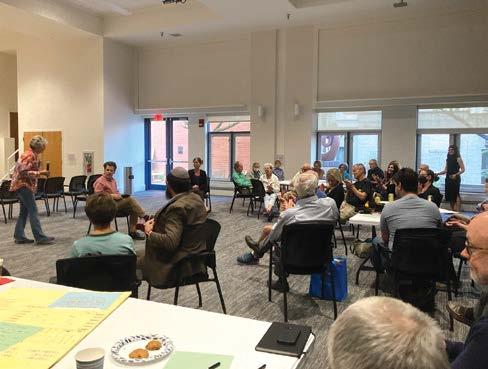
Our theme for this magazine issue is Making a Home. Our homes were truly our safe spaces when we hibernated during the pandemic. We know the importance of having a place where we feel our best and can invite our friends and family to enjoy special times. As we move into fall, we look to the coziness of home to comfort us as students go back to school and we welcome more people into our space to enjoy fun times and holidays together.
Our Squirrel Hill community merchants offer so many ways to help us create wonderful experiences in our home. Here are some highlights and hacks!
Games Unlimited offers amazingly fun board games. They have everything you need for an exciting family or friends game night! If you want something calmer, Dobra Tea and Blue Monkey Tea offer delicious teas from all around the world. What could be cozier than a good cup of tea to share at home?
Enjoy your own foodie tour at home by ordering takeout from our incredible restaurants and bakeries. You can create a DIY Asian food tour with Silk Elephant, Taiwanese Bistro 33, Took Took 98, How Lee, Chengdu Gourmet, Kiin, Diners 2+1 and more! Pair with sweet treat from Pink Box or Sumi’s Cakery.
We have probably all created our own pizza war at home by ordering takeout from Aiello’s and Mineo’s then voting for which is our favorite. Why not add Napoli’s, Pastoli’s, and Pizza Bellino to round out your choices? Add desserts from Gabe et Jules, Prantl’s, The Chocolate Moose and more to create a fun, delicious at-home event for family and friends. Or make it easy with a one-stop
28 | shuc.org
shuc snapshots
shop like IBC/Hidden Harbor or Murray Avenue Grill! No matter what your family enjoys we offer it in Squirrel Hill for you to design a “choose-your-own adventure” evening at home!
At SHUC, all of Squirrel Hill is our home, and we are looking very forward to a wonderful, fun-filled fall. Upcoming events include the potential return of our CommUNITY Day and other seasonal staples like Halloween in the business district, our October Night Market, another highly anticipated DOORS OPEN Walk Squirrel Hill! Sukkot tour with some special guests, our annual Treasure Awards Dinner with our absolutely amazing 2023 Treasures, the Holiday Wine Walk and more. Hope to see you at one or more!
Please reach out to share what you would like the Squirrel Hill Urban Coalition to continue, feedback about changes that you would like to see in our Squirrel Hill community, and your thoughts and ideas to help support us in preserving, improving, and celebrating the quality of life in our vibrant Squirrel Hill community. Volunteers are always welcome and appreciated! You can connect with me at mcohen@shuc.org.
Protect Our Parks and Gardens Update
The city-wide Protect Our Parks and Gardens committee is working through the “Components of a Deer Management Plan” published by the Pennsylvania Game Commission. The initial steps involved drafting a mission statement and establishing attainable goals for deer management activities. Some listed outcomes include reducing the number of vehicle collisions with deer; reducing the destruction of native understory and canopy; minimizing deer destruction of landscaping; and educating residents on actions that will reduce deer, human, and pet conflicts.
To learn more about current strategies in the parks, the committee recently joined Brandon McCracken, Pittsburgh Parks Conservancy Restoration Gardener, on a visit to Frick Park’s approximately three acres of enclosed 8’ fenced park land. Using such enclosures to keep deer out of the area allows native plants to flourish without damage from browsing deer. In addition, once the enclosure is restored with natives and established, the plants and trees inside it will produce seeds that can spread to other parts of the park system, further strengthening the native environment.
The committee is also collecting photos and documentation of deer collisions, deer damage and destruction of habitat, and other aspects of harm to our parks’ ecosystem. In addition, the committee is reviewing deer management tools and options for the city that will balance deer with habitat and is developing public education materials, including a Q & A. Stay tuned for updates in the SHUC newsletter “In a Nutshell” and this magazine.

Summer/Fall 2023 | 29
SHUC SNAPSHOTS
Litter Patrol’s Clean Sweep

SHUC’s Litter Patrol celebrated Earth Day in April with a spectacular weekend of learning and service. On Saturday, April 22—Earth Day proper—community members gathered at Summerset at Frick Park to learn about composting, make seed bombs, and conduct a mini litter patrol. Then, on Sunday the 23rd, dozens of volunteers braved a chilly spring morning to pick up litter on the streets of Squirrel Hill.
This was the first event of Clean Sweep Week. Throughout the week, more than 200 generous litter picker-uppers, including teams from St. Edmund’s and Starbucks, participated in the cleanup. SHUC’s Litter Patrol provided supplies, and local merchants donated prizes for awards like the oldest and youngest participants, the most trash collected and the most unusual trash collected, and the winners of Clean Sweep Bingo. Huge thanks are due to Blue Monkey Tea, The Chocolate Moose, European Wax Center, Games Unlimited, Little’s, Phipps Conservatory, Riverstone Books, The Refillery, and Starbucks (both Squirrel Hill locations!) for their contributions.
SHUC also thanks its dedicated Litter Patrol team for organizing these events, as well as McGruff the Crime Dog and Officer Vicky and Zeke her patrol dog for visiting with our volunteers. A special shout-out is also due to Rachel Lecrone for her leadership in the Litter Patrol.
The Litter Patrol continues to help keep Squirrel Hill clean, especially during the well-attended Night Markets. Volunteers are still needed for the August and October events, as well as for the Adopt-a-Block program and more informal clean-ups. If you want to help, e-mail Rachel Lecrone at Rachel.a.lecrone@gmail.com or call the SHUC office at 412-422-7666.
SHUC SAYS “THANKS!”
The Lunar New Year arrived in Squirrel Hill with a parade up Murray Avenue on Saturday, February 25. Led by Grand Marshals from the Tzu Chi Foundation, the parade delighted guests with dancing dragons, marching bands, martial artists, dancers, and a vision of Pittsburgh’s diverse Asian communities. SHUC would like to thank Hilda Fu and her grandchildren, Marian Lien, Chiapih Shaw, and Evelyn Young of OCA, Minadeo PTO and students, and AmeriCorps and SHUC volunteers for helping make this event a success.
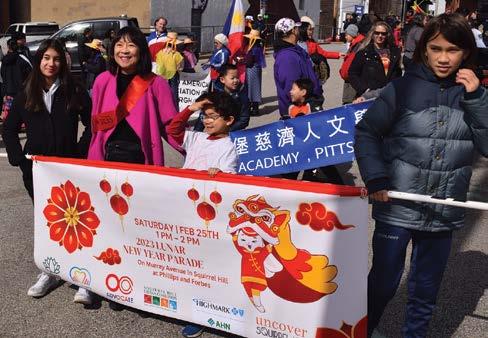
Thanks to its community allies, SHUC had a very busy spring. We’d like to thank Friends of Mellon Park for including us in their April Arbor Day event; the Playful Pittsburgh Collaborative and its partners for welcoming us to their Ultimate Play Day in May; and Lisa Ceoffe and the Lawrenceville Memorial Day Parade for inviting Murray the Squirrel to participate! We’re so glad to be able to make these kinds of connections and serve communities across the city.
Closer to home, we joined Uncover Squirrel Hill’s Mother’s Day Wine Walk through the business district in May. As guests explored the
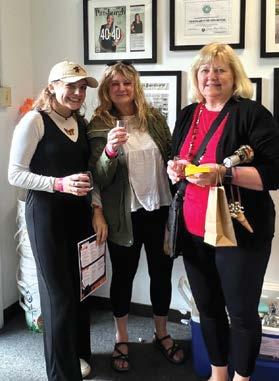
30 | shuc.org SHUC SNAPSHOTS
offerings in each of the participating merchants, we were graciously housed by The Refillery. Thank you, Larissa Russo, for giving us space, and thanks to all who joined in the festivities!
SHUC and those interested in the gateway to Squirrel Hill are so appreciative of the work that Michael Rosenbaum does to keep the garden at the parkway entrance looking terrific, even under difficult weather conditions. The neighborhood is grateful Michael. Thank you so much!
Finally, from the bottom of our hearts we thank Barb Grover, who after a long period of service to SHUC (including as a board member and head of the Litter Patrol) is moving away. We’ll miss you very much, Barb!

GREENERY IN THE BUSINESS DISTRICT


As spring turned to summer earlier this year, visitors and residents of the Forbes and Murray business district were greeted by new planters filled with shrubs and flowering plants. SHUC joined with Uncover Squirrel Hill to coordinate the fundraising for and installation of these streetscape enhancements. Eagle-eyed pedestrians can spot the plaques on the planters honoring the individual contributors who so generously donated funds for the project. Special thanks to Jamison Combs for his efforts.

Announcing the 2023

Squirrel Hill Treasures
The Squirrel Hill Urban Coalition is excited to reveal its Squirrel Hill Treasures of 2023:
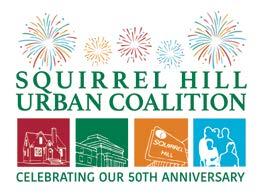
Ellen P. Kessler, a leader working on behalf of Pittsburgh nonprofits

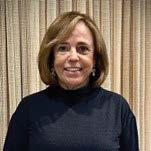
Elizabeth Miller, MD, PhD, a physician focused on the wellbeing of children
Helen Wilson, a historian committed to keeping Squirrel Hill’s past alive
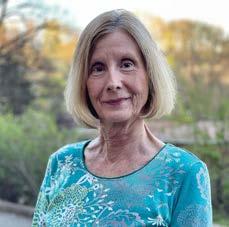
Jewish Family and Community Services Pittsburgh, an agency providing help where it’s needed.
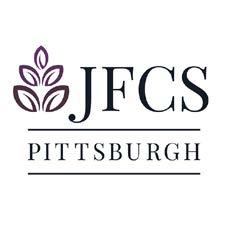
Their dedication to Squirrel Hill, Pittsburgh, and communities beyond our city is extraordinary. We hope you’ll join us in honoring them at the Treasure Awards Dinner on Wednesday, November 8, 2023, from 6 to 8 pm at The Pittsburgh Golf Club.
For dinner tickets and sponsorship opportunities, visit https://shuc.org/events/sh-treasure-awards/ or call 412-422-7666.
32 | shuc.org
Violins of Hope Combine Music and Holocaust Education
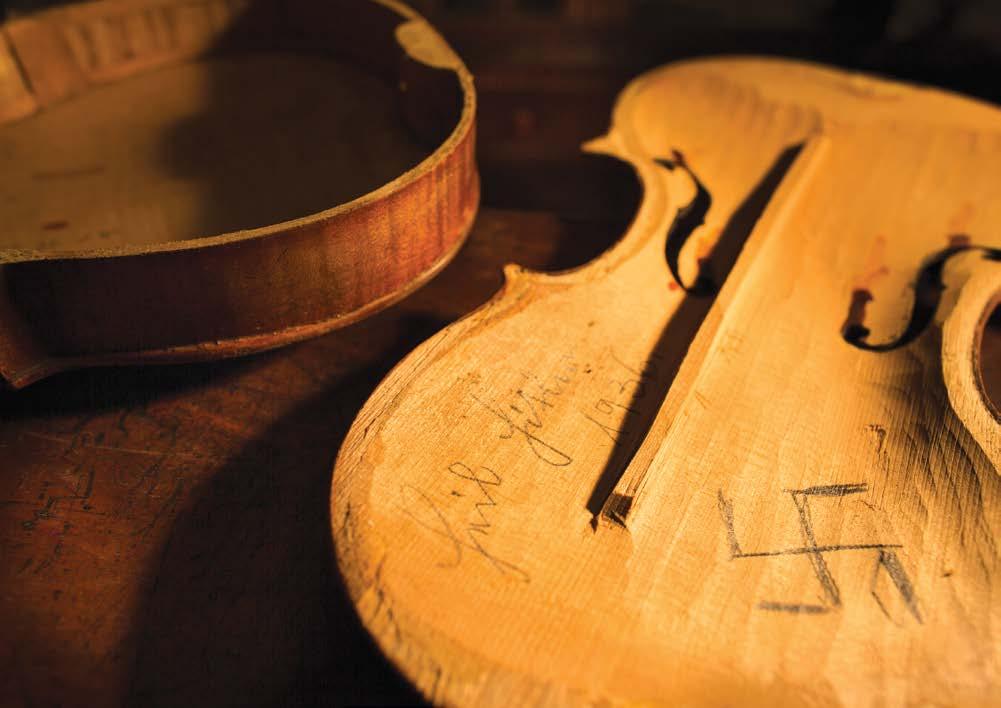 by Luke Chinman
by Luke Chinman
IN THE EARLY MONTHS OF 2019, SANDY ROSEN NOTICED A CALL FOR DOCENTS AT AN EXHIBIT NAMED “VIOLINS OF HOPE” IN PHOENIX . She immediately signed up for the gig and was taken by its cultural and musical resonance. Four years later, the traveling set of historical instruments is coming to Pittsburgh this fall, all thanks to her tireless coordination.
For over a decade, father and son violin-makers Amnon and Avshi Weinstein have cultivated a private collection of instruments, acquiring violins owned by Jews before and during the Second World War. Since undergoing an intricate restoration process at their workshop in Tel Aviv, the violins have been played by dozens of symphonies. But beyond their use as musical instruments, the Violins of Hope are a potent symbol, considering Nazi attempts to confiscate musical instruments throughout Hitler’s regime, and an
unconventional educational tool to teach and remember the history of the Holocaust.
“I saw the power of the stories and the lessons that the people behind the stories were able to help convey,” Rosen, who is now the Chair of Violins of Hope Greater Pittsburgh, remembered of her first encounter with the exhibit in 2019. “I said to Avshi Weinstein, ‘You have to come to Pittsburgh.’”
It was easier said than done. Since the first time they were played during a concert in Jerusalem in 2008, the collection has been in high demand, jetting off to destinations across Europe and North America, and the earliest Rosen could book the violins was for October 2023.
After the dates were fixed, Rosen—with the help of Co-chair Pat Siger and Project Manager Lynn
Summer/Fall 2023 | 33
A violin with antisemitic inscriptions on its interior.
© Daniel Levin 2021.
Zelenski—scoured Pittsburgh for a set of community partners to help create artistic and educational experiences throughout the city while the violins were in town.
Carnegie Mellon University will showcase the violins in the Posner Center throughout October and November at an exhibit that is free and open to the public.
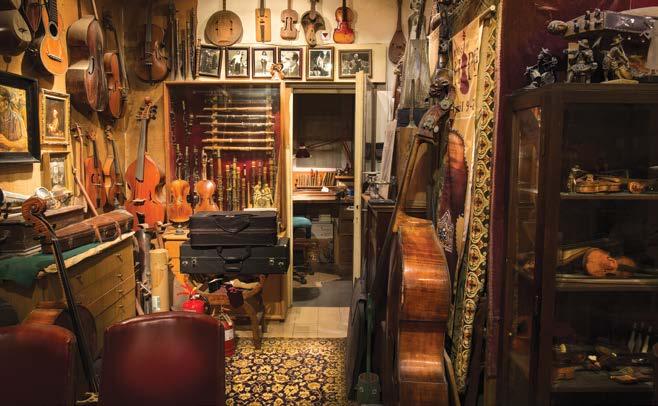

Though they expect the exhibit to be well attended day in and day out, the organizers have made a concerted effort to ensure that the exhibit reaches Pittsburgh’s youngest minds. They plan to bus students from dozens of middle and high schools across the city to the Posner Center and are providing educational materials about the Holocaust for teachers to use in the classroom as supplementary material.
“There’s a whole generation of young people who have no knowledge of the Holocaust,” Siger said. “We wanted to take away every barrier humanly possible so that students would come and teachers would be well prepared.”
Of course, the violins will not only be on display during their time in Pittsburgh. The organizers have an array of musical performances lined up: Pittsburgh Symphony Orchestra will show off the collection at Heinz Hall on October 18; Pittsburgh Ballet Theatre has commissioned a new work based on the life of a Jewish ballroom dancer in Nazi Germany to debut on October 27; and CMU’s Philharmonic Orchestra will perform the work of Felix Mendelssohn, a composer with Jewish heritage, on November 5.
And this is just the tip of the iceberg. Musical performances will be scattered throughout the region, extending from State College to Wheeling, W.Va. “It
has been thrilling and personally enriching,” Rosen said of bringing so many artistic partners together. “Everywhere we went, people said yes.”
34 | shuc.org
Amnon Weinstein works on a historical violin.
The interior of the Weinsteins’ workshop.
© Daniel Levin 2021.
© Daniel Levin 2021.
In Squirrel Hill, the American Jewish Museum, which is housed inside the Jewish Community Center, is working alongside the University of Pittsburgh’s Jewish Studies Program to exhibit a collection of photographs by Daniel Levin chronicling the restoration process of the Violins of Hope in Tel Aviv.
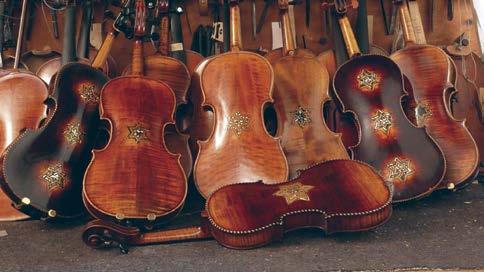
“I thought that was a remarkable opportunity to shine a different kind of light on the overall program,” said Melissa Hiller, Director of the American Jewish Museum and curator of the exhibit.

“What is special about this photographic suite is that each one has a very rich backstory,” Hiller said. In the exhibit, which is free and open to the public, each image will be accompanied by a QR code that visitors can scan to listen to Levin give his account of the photograph.
Violins of Hope Greater Pittsburgh will feature exhibitions, events, and learning opportunities throughout October and November 2023.
The Violins of Hope exhibit at CMU’s Posner Center runs from October 7 to November 21.
Daniel Levin’s photographs will be displayed at the American Jewish Museum in the Jewish Community Center in Squirrel Hill from October 15 to December 8.
For more information, call 412-260-1968 or visit violinsofhopepittsburgh.com.
Life synagogue nearly five years ago. “It is not just a historical event,” she said. “That kind of hatred is alive and present and is a part of every historical moment.”
The photographs are also significant, Hiller explained, because they depict new insights revealed by the violins’ restoration. One image, for instance, depicts the words “Heil Hitler 1936” scrawled on the inside of an opened violin during Weinstein’s restoration work—a hidden history not visible by merely looking at the fully assembled instruments.
The inclusion of this historical episode in the photo exhibit at the American Jewish Museum, Hiller added, is especially relevant following the massacre at Tree of
According to Rosen, this context—as well as rising instances of antisemitism in recent years— makes the educational experiences offered through the Violins of Hope even more vital.
The organizers anticipate that their suite of programming will be felt across the city. Siger said that she wants to reach over 200,000 people in some way while the violins are in Pittsburgh—whether at an exhibition, a musical performance, or a lecture.
“We are hoping that our message will bring more joy, more inclusion, more resistance, and more hope to our community.”
Some of the Violins of Hope that once belonged to Jewish musicians.
Summer/Fall 2023 | 35
Violins of Hope Greater Pittsburgh.
GOOD NEWS FROM OUR SCHOOLS PUBLISHES REPORTS CONTRIBUTED BY OUR LOCAL SCHOOLS.
PITTSBURGH MINADEO
Through a partnership with The Boy Scouts of America’s Trailblazer Program, Minadeo students got to participate in some amazing activities this year! Starting in the fall, we celebrated the season by going on a field trip to Camp Guyasuta. Students learned how to shoot a bow and arrow, played team building games, and sped down a zipline. In November, students were taught about Veterans Day and how to honor the American flag. The following month, students learned about structural integrity and delicious design by building gingerbread houses. Come spring, the students assembled and decorated their own Pinewood Derby cars, culminating in a race on May 10. The students learned so much from these activities and had a great
ST. EDMUND’S ACADEMY
On May 12 and 13, St. Edmund’s Academy hosted their second annual Wolfpack Weekend, a weekend full of events celebrating the community.

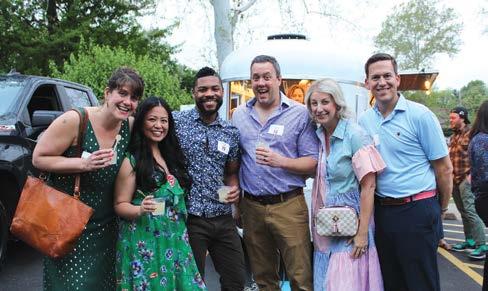
On Friday, May 12, SEA welcomed the Grandfriends of students, inviting grandparents, special friends, neighbors, etc. to visit the school. Grandfriends watched performances in the SEA Auditorium, heard
time participating. Minadeo is excited to be continuing this partnership next year!
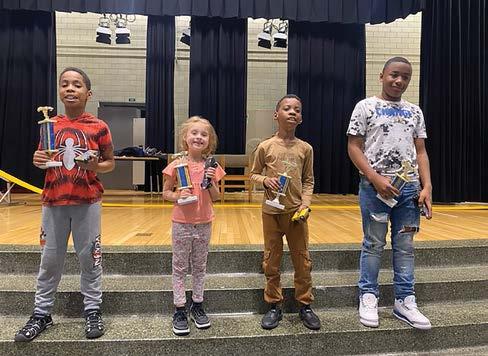
36 | shuc.org
GOOD NEWS FROM OUR SCHOOLS
[Left] St. Edmund’s Academy students race through Schenley Park as part of the Wolfpack Weekend.
[Below] The Great Event turned the St. Edmund’s Academy parking lot into a party spot.
Minadeo’s outstanding Pinewood Derby racers: Chance Moses, Riley Richards, Khi’ayre White, and Tevaraus Davis
from Head of School, Dr. Chad Barnett, and then enjoyed time with their student in their classroom doing different activities including math challenges, crafts, time on the Playdeck, and pickleball in the Coach Gathagan Gymnasium.
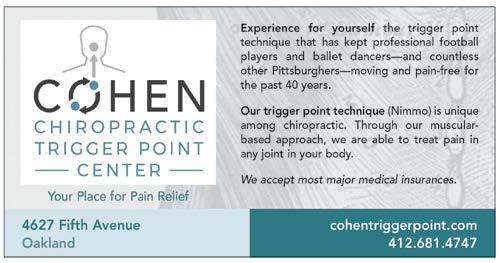



That afternoon SEA welcomed alumni currently in high school back to campus for Grad Bash! Alumni had the chance to visit with teachers and each other while walking through the school and playing on the field. That evening, parents, faculty, and friends came together in the SEA Forbes parking lot for The Great Event, an evening with food trucks, dancing, and signature cocktails made by local mobile bar The Parched Pony.
The following day on Saturday May 13, SEA families braved the rain to run in the Wolfpack 3+1 Miler held at Schenley Park, followed by the first ever Pack Pet Parade, which gave families the chance to celebrate EVERY member of their pack.
The False Alarm
by Cole Cohen, rising senior
ON WEDNESDAY MORNING, APRIL 12, SCHOOL STARTED NORMALLY AT CENTRAL CATHOLIC HIGH SCHOOL. The day went along like any other day—classes, friends, schoolwork—until it was lunch. I was standing in the lunch line when the lockdown alarm went off. The teachers herded us into a corner.
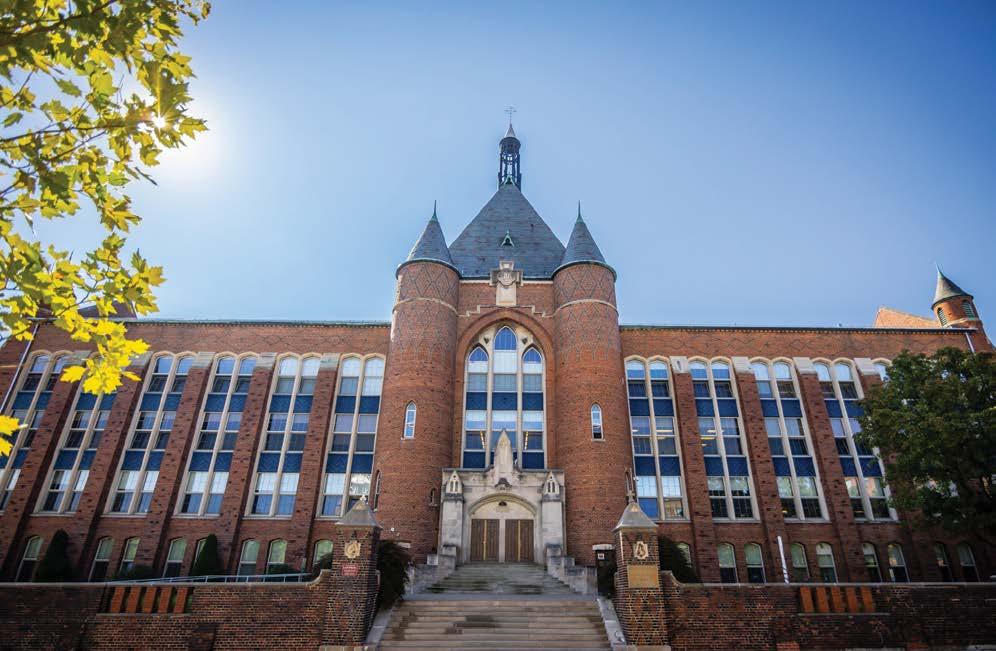
Then a fellow student’s boss called and told him that 6 students had been shot in the STEM building. The STEM building is the science building across the parking lot. My brother was in the STEM building.
Police came into the lunchroom carrying AR-15 machine guns. Another police officer was carrying a sniper rifle.
We eventually got the call that everything was okay.
Later, I heard about my brother Julien’s experience. He was walking into the STEM building and was directed into a bathroom. Multiple police officers were outside of the building with machine guns. He was confused
at first, but then got bored while waiting to hear that everything was okay.
Once things calmed down, I was able to have a vice principal call my dad and get me released. I drove home after that.
I was very hungry and tired after all of this. After all, the lockdown came just as I was about to get lunch. It was interrupted by the false alarm, so my classmates and I did not get to eat. My brother and I stopped at Jersey Mike’s for hoagies, which helped.
38 | shuc.org YOUTH VOICES
At that point we were just thankful that everyone was safe …
at Central Catholic High School and resident of Squirrel Hill
Photo courtesy of Central Catholic High School.
After lunch, I was tired, so I took a nap. When school announced that it would close for a few days, Julien and I were both happy that we got extra spring break. At that point we were just thankful that everyone was safe and that the school handled it well.
Our teachers were really good at controlling the situation. We felt safe.
It makes me feel safe to know that my school has a well-structured protocol for active shooter alerts. It was very reassuring to witness how my teachers had a plan in place, calmly followed it, and did what they were supposed to do. It makes me feel safe to know that I am at a school where my only focus needs to be my schoolwork.
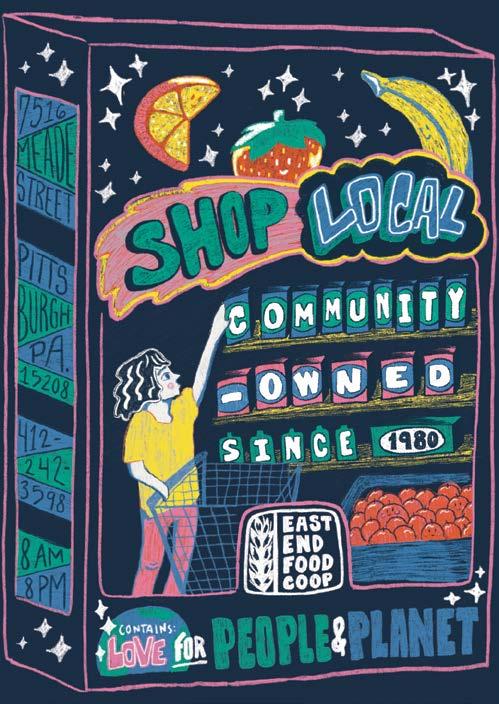
It makes students feel unsafe when they come to school every day thinking that they are going to be shot or killed.
Central Catholic is in an area with more police and security, which makes it feel safer. It would feel less safe if we did not have as many security precautions taken or as much police presence.
My classmates and I learned that we need to be calm and follow the policy in place when there is an active shooter threat. Since everyone followed the protocols in place, we were and, I can hope, would have been safe if there had been a real threat.

My advice from what I experienced is, if you are in an emergency situation, be calm, have a structured plan in place, and follow the plan. This experience really made me feel and understand that it is very important to be calm and aware, and to think quickly if there is an active shooter alert or another emergency. I hope that every school has a strong active shooter protocol in place and teachers/team members who will follow it as well as my school, Central Catholic High School, did on the morning of Wednesday, April 12.

YOUTH VOICES
PETS WORK HARD TO MAKE A HOUSE A HOME
By Lawrence Gerson, VMD
When my mother-in-law Doris decided to leave her long-time family residence, she moved to a patio home. The unit was on one floor and convenient, but she was lonely. At that point, she adopted Pookie, a black and white tuxedo cat. Her new pet made the difference between a house and a home. Years later, Doris made another decision to move to an assisted living situation. Pookie was able to stay with her in her new residence, making the life-stage transition much easier.
I had a similar experience with a pet easing me into a new phase of my life. Veterinary school was difficult for me in so many ways, but as a
freshman, my roommate and I decided to adopt dogs to help with the stress. My Saint Bernard cross named Vastus made life easier and provided some stability to an otherwise stressful home away from home.
Dogs also provide a sense of security at home. My wife and I have always had large dogs. We’ve often had a large dog for protection and a small dog to be a sentinel as they are more alert to noise. Working late hours, I always felt my wife was safer with dogs to


40 | shuc.org PET POINTS
A watercolor of Vastus, Larry’s vet school companion.
guard the home. Experts will tell you that a dog is a significant deterrent to crime.

After a yearlong discussion of different breeds, my son finally found the perfect dog for their family. Royce is a hundred-pound-plus Bernese Mountain Dog and a big bundle of joy for my son’s two children. However, when strangers come to the door, Royce becomes very protective with a fierce bark. Dogs make the home a sanctuary, especially for children.
My daughter followed me in a career path and became a veterinarian. Her children have a 14-year-old hypoallergenic goldendoodle who is always there to comfort them and provide a home full of love. Their choice of breeds was necessary to limit allergens in the house. With the addition of a new puppy named Tug, the now two-dog household turned into a three-ring circus at their happy home.

Beyond my family, it’s clear that animals can help people transition into new living environments. At a recent seminar on professional mental health, we heard about a program of suicide prevention for military veterans suffering from the trauma associated with serving our country. The program used horses to help reorient the soldiers to being home and readjust to civilian life. The results were amazing, and the program was unbelievably successful in preventing self-harm. Returning home can be difficult for those who serve, and animal therapy is a fantastic tool in the transition to everyday life.
Youthful offenders at the county jail now have a comfort dog to help them adjust to their new “home.” It is heartwarming to see the criminal justice system recognize the need for using every option to help these kids get back on track. Link, an Australian Shepherd, and Megan, his handler, visit monthly. “We are excited to bring Link and Megan to the Allegheny County Jail,” Allegheny County Jail Warden Orlando Harper said. “Therapy dogs have been shown to be helpful in supporting both academic and psychological growth, promoting self-esteem and increasing social skills. We are pleased to be able to offer this opportunity to our incarcerated juvenile population.”
In multiple situations animals can have a beneficial impact on the lives of people who embrace the love of our four-legged friends and welcome them into our homes.
Summer/Fall 2023 | 41 PET POINTS
Her new pet made the difference between a house and a home.
Vastus and Larry’s daughter, now known as Dr. Berger.
By Helen Wilson, Vice-President, Squirrel Hill Historical Society
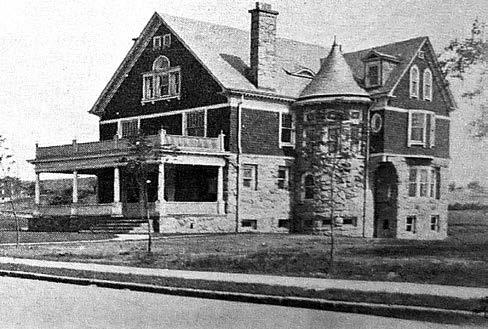
MOVING UP TO SQUIRREL
THIS IS THE 50TH COLUMN I’VE WRITTEN FOR SQUIRREL HILL MAGAZINE.
In the previous 49, I’ve discussed factors that created the Squirrel Hill neighborhood we know today—first and foremost, that it stayed undeveloped long after the valleys around it became bustling residential and industrial centers. The hill’s steep slopes were hard to climb until electric trolleys came along in 1893. Before that, farms and large country estates dotted the hill; after that, Squirrel Hill developed at frenetic speed—but not evenly. The neighborhood grew in spurts, and the different areas of homes, townhouses, and apartment buildings in it result from the way it grew.
Paths of development followed trolley routes. First to develop were areas up from Fifth Avenue, such as Murray Hill Avenue and Woodland Road, because cable cars began to run from Downtown to East Liberty along Fifth Avenue in 1889. Murray Hill Avenue, with its Belgian-block road surface, contains fine examples of early twentieth-century domestic architecture, built there specifically because of easy access to Fifth Avenue. In 2000 it became the Murray Hill Avenue City Designated Historic District.
42 | shuc.org SQUIRREL HILL HISTORY
This home once stood at the corner of Forbes and Murray on the site of the Rite Aid building. Photo from Squirrel Hill Homes by Reed B. Coyle & Co., undated [ca. 1900]. Detre Library, Heinz History Center.
SQUIRREL HILL
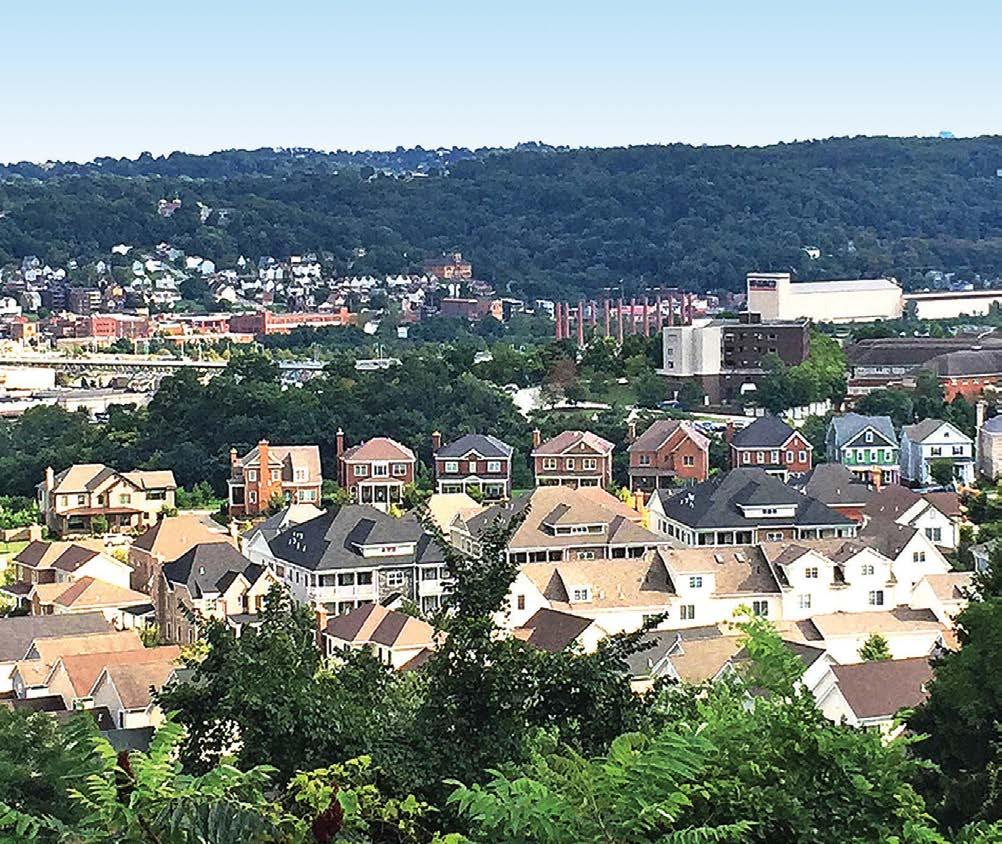
Murray Hill Avenue is just one of many discrete areas of Squirrel Hill that developed in response to changing conditions. Shortly after electric trolleys came to the hill in 1893, a line of mansions grew along the stretch of Forbes from Oakland to Murray Avenue. In fact, mansions and large houses were built all over the northern half of Squirrel Hill as the old farms and estates were divided into smaller but still sizeable lots. Real
estate developers built large homes for the managerial class of industry and commerce because trolleys made living farther away from places of employment easier. Murdoch Farms, once well known for its fruit trees and flowers, became an upscale residential area.
Trolleys connected Downtown Pittsburgh with bustling industrial and commercial centers such as Homestead,
Summer/Fall 2023 | 43 SQUIRREL HILL HISTORY
Beyond the houses of Summerset at Frick Park one can see smokestacks across the Monongahela River, a reminder of the area’s industrial past.
Photo by Helen Wilson, 2023.
McKeesport, East Liberty, Wilkinsburg, and Braddock— and they ran through Squirrel Hill to get there. The Forbes-Murray business corridor began to grow along their paths. Murray Avenue, which had been residential, became commercial. Some of the houses are still there, hidden behind the storefronts.

Business districts need a dense population to flourish. When automobiles came along in the early 1900s, real estate developer Thomas A. Watkins conceived the idea of making apartment living fashionable for the same reason people move to condos today—gracious living conditions without the hassles of home ownership. In the 1920s, Watkins built the elegant Morrowfield Apartment Hotel on Murray and 46 smaller apartment houses of various sizes behind it. He situated them to take advantage of the new Boulevard of the Allies
that made Downtown only minutes away by car. The population density of the Watkins Development was a major contributing factor to the growth of Squirrel Hill’s business district. Other developers built rows of small apartment buildings on Hobart and Wightman streets and Munhall Road. Watkins and other developers also built “urban villages” throughout Squirrel Hill—clusters of townhouses usually built around a central common area—such as Forbes Terrace and Beacon Commons (originally Hamilton Cottages).
The Boulevard of the Allies was a conduit of another kind. It brought Eastern European Jews from the Hill District and Oakland to Squirrel Hill. The smaller houses that fill the southern half of Squirrel Hill today were mostly built in the 1920s and 1930s. Many of
micro-areas
44 | shuc.org SQUIRREL HILL HISTORY
Old houses can be spotted behind Murray Avenue storefronts between Hobart Street and Phillips Avenue.
Photo by Helen Wilson, 2023.
Squirrel Hill is filled with such housing
the people who bought them were Jewish. Earlier in the 1900s, Americanized German Jews had moved to Squirrel Hill, mostly to the northern part, but the
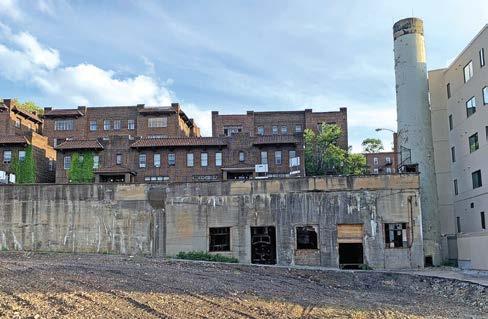

business district took on its Jewish character because of the influx of Eastern European Jews.
Every area of Squirrel Hill has its raison d’être Frick and Schenley Parks bookend Squirrel Hill east and west but differ dramatically in appearance and purpose—Frick is wild and Schenley is groomed. Beacon Heights offers gracious mansions on the highest point in Squirrel Hill while Nine Mile Run valley and the Duck Hollow Trail beside the Monongahela River hold remnants of the neighborhood’s industrial past. The area on the west side of Browns Hill Road on Imogene Road and Desdemona Avenue began as a “coal patch” community for W. H. Brown’s miners and steamboat crews. His large estate was where the Jewish Association on Aging now sits, on the other side of Browns Hill Road. The new Summerset at Frick
SQUIRREL HILL
HISTORY
After the demolition of the Squirrel Hill Theater, apartment buildings from the Watkins Development and the original power plant for the Morrowfield Apartment Hotel were visible from Forward Avenue.
Photo by Helen Wilson, 2021.
Park residential development is built on an old slag dump, which buried part of the once-scenic Nine Mile Run valley under ten stories of slag between 1922 and 1972. Carnegie Mellon and Chatham Universities are their own universes, drawing people from all over the world to live here.
Squirrel Hill is filled with such housing micro-areas, and what is interesting is that vestiges of the past are still visible today. A street filled with smaller houses might have an older, more elaborate house in the middle of it. At the same time, another street might have houses from the 1920s with a new state-of-the-art house in its midst, showing that the neighborhood continues to develop.
Changes are visible in the populations that dwelt in these homes as well. The European settlers who arrived to claim what had been Native American seasonal hunting grounds were first French and then


mainly Scots-Irish and German. A few British military men bought acres of land (including what became the tract where the Neill Log House was later built). A few enslaved people were part of the population, but slavery was gone in Squirrel Hill before 1840. As mentioned above, Squirrel Hill took on its distinctive Jewish character in the first quarter of the 1900s, when Eastern European Jews moved in. People from China and other parts of Asia opened laundries and restaurants in the same decades. Middle Easterners, notably Syrians, also had a presence, particularly around Munhall Road. Italian landscapers, beginning with the Caliguiris, have a long history in Squirrel Hill.
Today, Squirrel Hill boasts the most diverse population in Pittsburgh, as illustrated by the businesses in the Forbes-Murray corridor. As new residents continue to arrive, they settle in a neighborhood whose history is visible in the very homes in which they reside.
46 | shuc.org
HISTORY
SQUIRREL HILL
Some of the newest houses in Squirrel Hill incorporate modern materials and environmentally conscious design.
Photo courtesy of Lucy de Barbaro.
UPCOMING EVENTS SQUIRREL HILL HISTORICAL SOCIETY
Anyone interested in learning more about Squirrel Hill history is invited to attend the programs of the Squirrel Hill Historical Society, held on the second Tuesday of each month at 7:30 p.m. The SHHS has returned to live programs at the Church of the Redeemer, 5700 Forbes Ave. The programs are also on Zoom. Go to www.squirrelhillhistory.org to request a link to the Zoom program and for updates and announcements of upcoming lectures and events. Please consider joining the SHHS. Membership is only $15 per year ($25 for families). There is no charge for attending the meetings.
AUGUST
There is no Tuesday evening meeting in August; however, a Log Splitting Demonstration will take place at the Neill Log House on August 5, time TBA on squirrelhillhistory.org.
Tuesday, September 12: “The Story of Dragon’s Den”
GIULIA LOZZA PETRUCCI, executive director of Dragon’s Den, a non-profit organization housed in the former St. Mary Magdalene Church on Amity Street in Homestead, will discuss the history of the building and how Dragon’s Den’s innovative programs teach youth from diverse backgrounds and abilities to overcome challenges in themselves, their communities, and the world.
Tuesday, October 10: “The Life and Accomplishments of Dr. Bernard Fisher”
Dr. STACY WENTWORTH, a radiation oncologist who practices in Winston Salem, NC, will explore the life and accomplishments of the late Dr. Bernard Fisher, a Squirrel Hill native and pioneer in the biology and treatment of breast cancer. Dr. Wentworth credits his work with saving dozens of her own patients’ lives, and many others.
Tuesday, November 14: “Hidden Pittsburgh History in Stained-Glass Windows at Heinz Chapel”
FRANK KURTIK, docent and events manager at Heinz Chapel, will discuss some of the historical events depicted in the windows of Heinz Chapel on the University of Pittsburgh campus. Frank previously worked for Sen. John Heinz III and for the Heinz Family Foundation. He was also Pitt’s first archivist in Hillman Library, organizing the Archives of Industrial Society’s original Pittsburgh City Photographer Collection.
SQUIRREL HILL HISTORY
Summer/Fall 2023 | 47
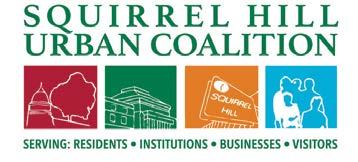




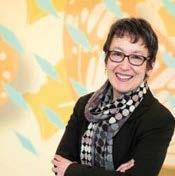

Wednesday, November 8 • 6 to 8 p.m. The Pittsburgh Golf Club To purchase tickets, visit shuc.org or call 412-422-7666. Treasure Awards Dinner You’re Invited to Attend the 2023
Ellen P. Kessler Helen Wilson Elizabeth Miller, MD, PhD Jewish Family and Community Services Pittsburgh







 by Luke Chinman
by Luke Chinman

































 By Lena Andrews, Vice President of Real Estate Development, ACTION-Housing
By Lena Andrews, Vice President of Real Estate Development, ACTION-Housing



 The lobster door handles at Krause Commons are a nod to the legacy of Poli’s restaurant, the previous occupant of the site.
Tenants of ACTION-Housing’s residential complexes thrive in Squirrel Hill.
The lobster door handles at Krause Commons are a nod to the legacy of Poli’s restaurant, the previous occupant of the site.
Tenants of ACTION-Housing’s residential complexes thrive in Squirrel Hill.


 By Allie Amoaye, Public Relations Specialist, JFCS
By Allie Amoaye, Public Relations Specialist, JFCS


 The JFCS’ refugee resettlement program held a workshop at the JCC in Squirrel Hill.
The JFCS’ refugee resettlement program held a workshop at the JCC in Squirrel Hill.

















 by Luke Chinman
by Luke Chinman


























